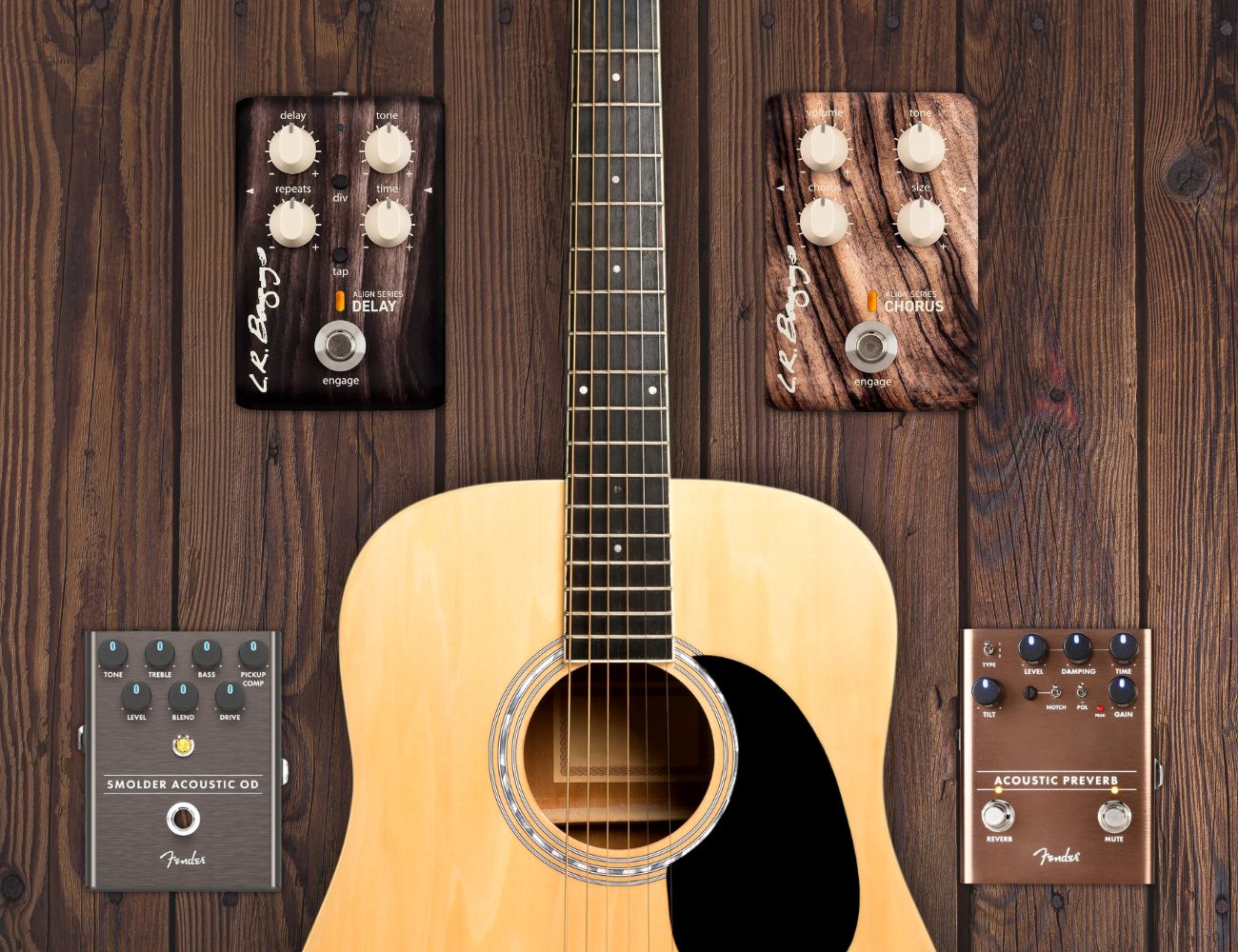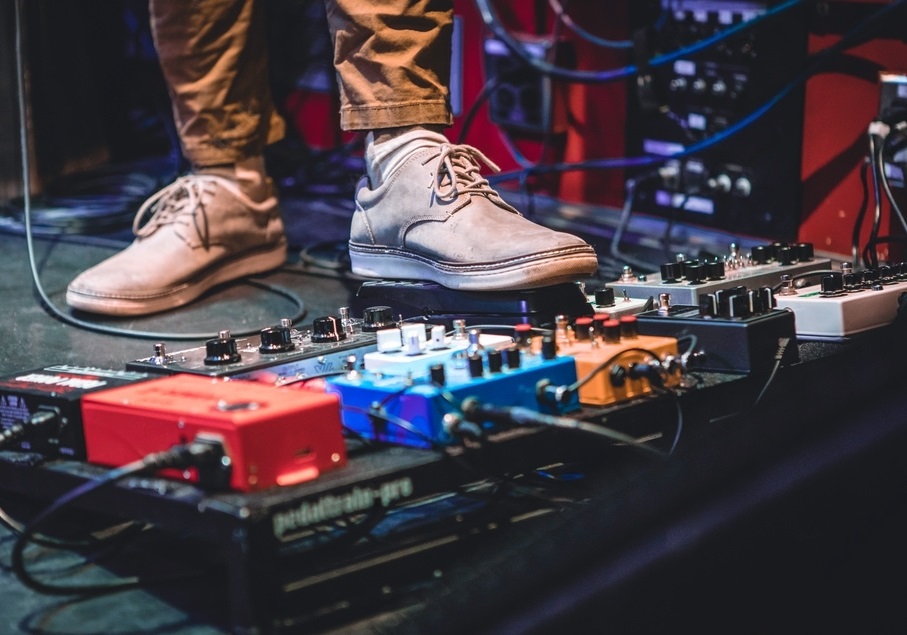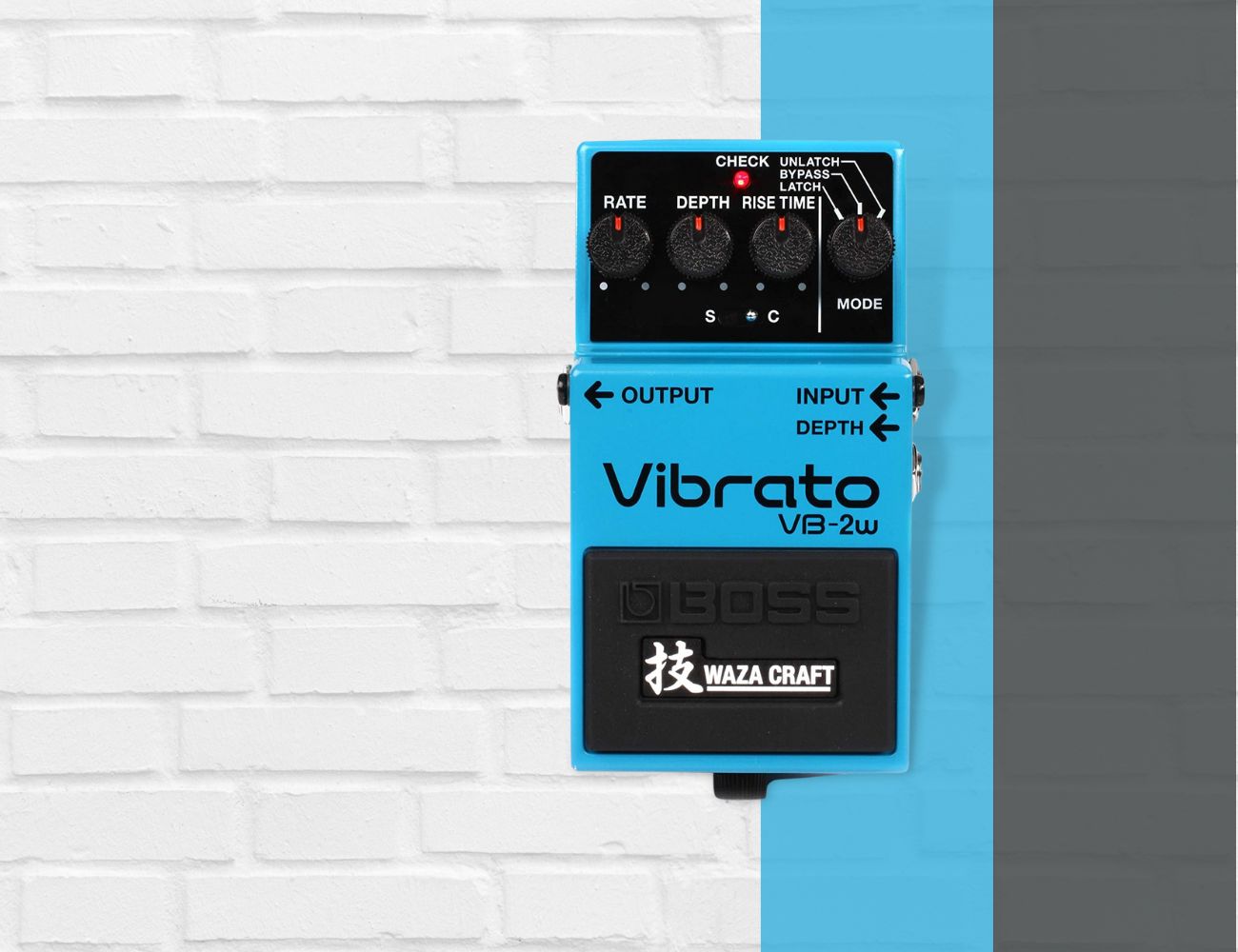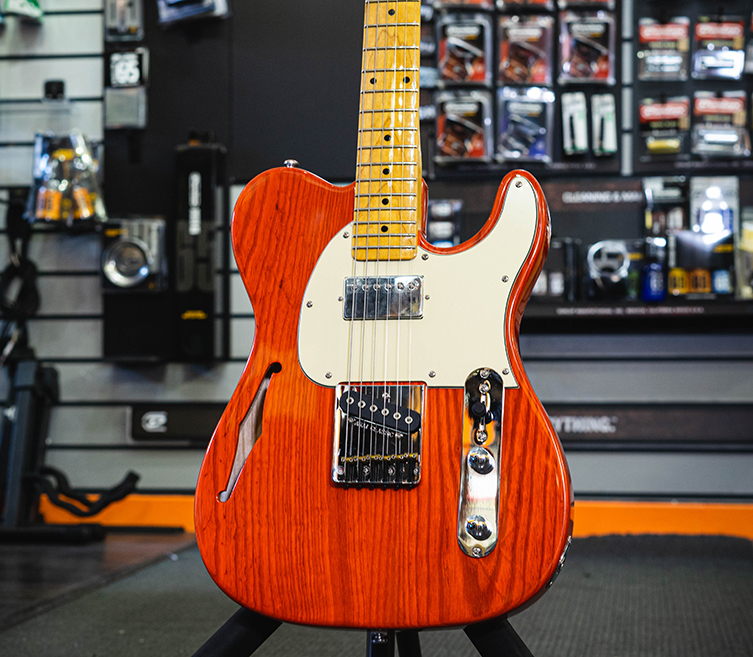Imagine the incredible sounds you could make with the best acoustic guitar pedals in your arsenal.
To really take your guitar playing to new heights, you’ll need a mix of passion, inspiration, fingers itching to play, and of course, the right gear.
In this article, we’ll guide you through the enchanting world of guitar pedals, saving you precious time and helping you find the perfect devices for your guitar.
Whether you’re into fingerpicking or strumming catchy rhythms, discovering the right acoustic guitar pedals can bring your creativity to life.
That’s why I’ve put together an informative and unbiased guide that will walk you through the main categories of acoustic guitar pedals: Reverb, Delay, Chorus, Loopers, and a few others.
Table of Contents
- Best Acoustic Guitar Pedals
- L.R. Baggs Align Chorus Acoustic Guitar Effects Pedal
- TC Electronic BODYREZ Acoustic Pickup Enhancer
- Fender Acoustic Preamp/Reverb Pedal
- TC Electronic MojoMojo Overdrive Pedal
- L.R. Baggs Align Delay Acoustic Guitar Effects Pedal
- Wampler Ego Compressor V2 Guitar Effects Pedal
- Boss DD-500 Digital Delay Pedal
- Wet Dreams Analog Chorus Effect Pedal
- Boss AD-2 Acoustic Preamp Pedal
- NuX Stageman Floor Acoustic Preamp and DI Pedal
- Strymon Flint Tremolo and Reverb Pedal
- MOOER Acoustic Guitar Effect Pedal
- Fender Smolder Acoustic Overdrive Pedal
- FLAMMA FS03 Guitar Delay Pedal
- MXR Phase 95 Mini Guitar Effects Pedal
- Boss CE-2W Waza Craft Chorus Pedal
- L.R. Baggs Venue DI Acoustic Guitar Preamp Pedal
- ISET Looper Pro Guitar Loop Effect Pedal
- Zoom A1 FOUR Acoustic Instrument Multi-Effects Pedal
- Boss ME-80 Multi-Effects Pedal
- What exactly is an acoustic guitar pedal?
- What should you consider when choosing an acoustic guitar pedal:
- How to properly use an acoustic guitar pedal?
- – Familiarize yourself with the controls and features:
- – Adjust the parameters to suit your musical goals:
- – Incorporate the acoustic guitar pedal into your signal chain:
- – Test the pedal’s functionality and performance:
- – Develop a unique tone according to your playing style:
- – Incorporate the pedal into your live performances or recordings:
- – Maintain and update your pedal as needed:
- How to order pedals on a pedalboard?
- Boutique vs. Mass-Produced pedals
- How much should you spend on a guitar pedal?
- Can you use a guitar pedal with a bass guitar?
- How to properly power your pedals?
Best Acoustic Guitar Pedals
Before I begin, here are my top selected choices:
Zoom A1 FOUR Acoustic Instrument Multi-Effects Pedal

Zoom A1 FOUR provides tailored effects for acoustic instruments with looper, rhythm section, and Guitar Lab support. Check Price
|
|
ISET Looper Pro Guitar Loop Effect Pedal

ISET’s quality audio products for musicians at affordable prices. Check Price
|
L.R. Baggs Align Chorus Acoustic Guitar Effects Pedal
Full, vibrant sound with L.R. Baggs Align Chorus Effects Pedal.
This pickup set provides a rich, balanced tone with clarity and definition, giving your instrument a subtle fullness. It comes with two single-coil pickups, a volume knob, and a tone control to adjust the sound to your liking.
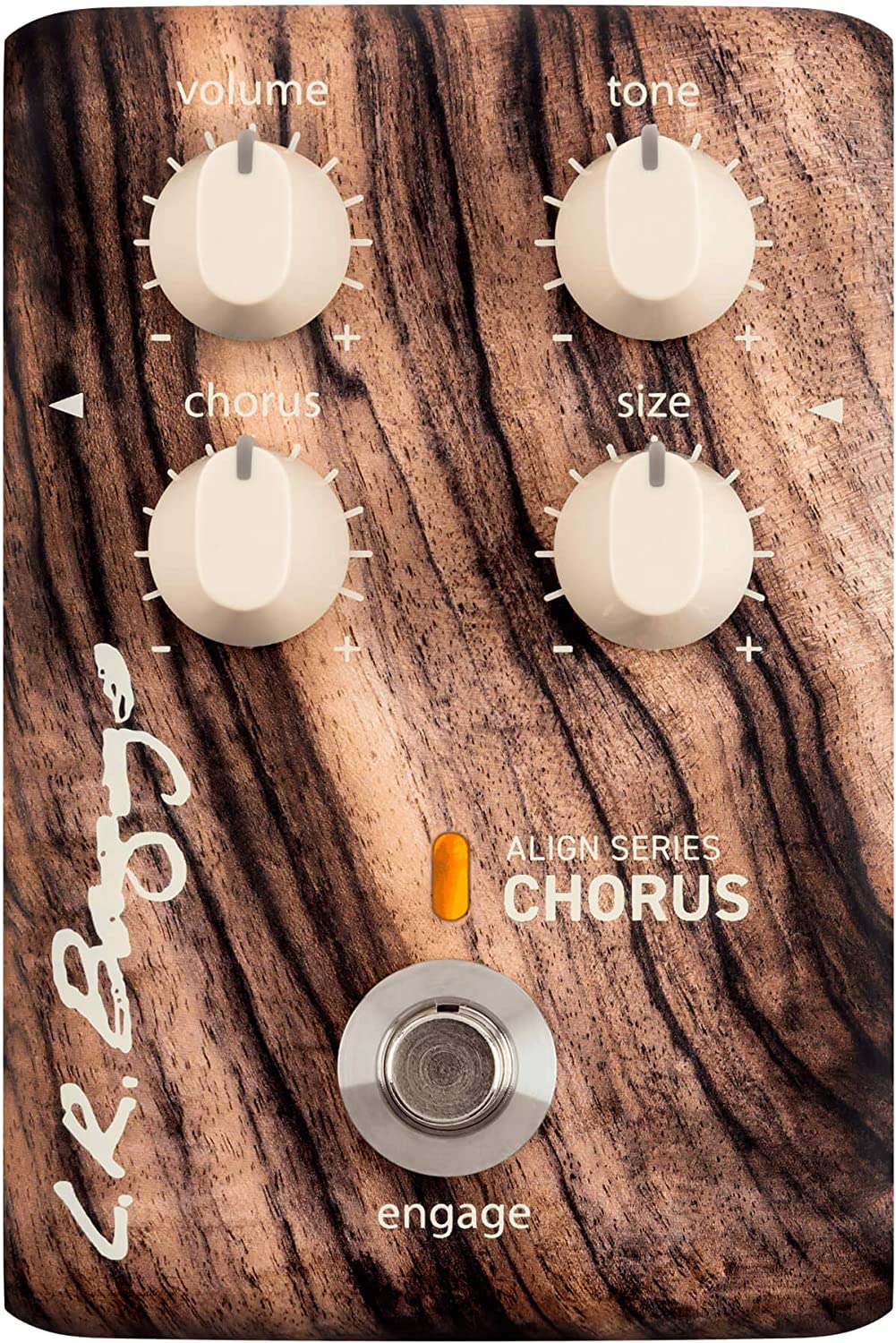
Crafted for acoustic guitars, the L.R. Baggs Align Chorus Acoustic Guitar Effects Pedal enhances your instrument’s natural resonance.
It blends the unaffected signal with a chorus effect, giving you a sweeping range of tonal possibilities.
A unique feature of this pedal is its Size control, which allows you to toggle between different chorus voicings for versatile applications.
Another notable attribute is its tone control, offering an expansive spectrum from warmth to radiance, catering to various musical styles.
A practical Engage footswitch is included to activate the effect or implement a true bypass, making it a breeze to switch your sound in live scenarios.
The volume level control also ensures your output stays where you want it.
This pedal isn’t merely an effect; it subtly enriches your guitar’s tone without overpowering its authentic sound.
- My Review
Stepping into the world of the L.R. Baggs Align Chorus Acoustic Guitar Effects Pedal was an experience.
Let’s talk about its highlight feature – the blend of the chorus effect.
It’s not your everyday chorus pedal; it leaves room for the original tone to shine.
You get that nice lushness added to your sound without losing the raw acoustic feel.
Now, the Size control is where things got interesting for me.
Switching between chorus voicings was a breeze, giving me this flexibility you rarely find.
It can shape the overall vibe of your performance to a significant degree, whether you’re after the whispery softness of a ballad or the rich vibrancy of a full-throttle rock performance.
The tone control is a thoughtful addition, giving you access to warm to radiant tones.
I found adapting to different room acoustics and music genres quite practical.
A warmer tone for an intimate coffeehouse gig or a more radiant one for a lively outdoor performance? No problem.
What did leave me wanting more, though, was the overall options for chorus types.
While the Size control is great, having a few more options would have made this pedal a complete knockout.
Simplicity has its charm sometimes.
But here’s what stole the show for me – the Engage footswitch.
True bypass or affected signal, it’s your call at the stomp of a switch.
Plus, the volume control does its job, and it does it well. No complaints here.
Here are the ratings I’ll give to the L.R. Baggs Align Chorus Acoustic Guitar Effects Pedal:
Having spent a good amount of time with this pedal, I thought it didn’t just add an effect to my sound; it introduced a subtle richness, a fullness that felt both distinctive and familiar.
This isn’t your regular chorus pedal; it’s a partner that works with you to create the tone you’ve been searching for.
- Pros:
- Preserves guitar’s tone.
- Simple controls.
- Subtle and full sound.
- Transparent and versatile.
- Cons:
- Limited chorus type options.
My final verdict is that the L.R. Baggs Align Chorus Acoustic Guitar Effects Pedal is a highly versatile and feature-rich pedal that delivers excellent tone and performance.
Its ability to preserve the guitar’s tone, simple controls, and subtle yet full sound provides musicians a transparent and versatile experience.
The positive reviews from real users further reinforce its quality and effectiveness.
While it may have limited chorus-type options, its overall value is commendable.
Therefore, I highly recommend the L.R. Baggs Align Chorus Acoustic Guitar Effects Pedal to guitarists seeking to enhance their acoustic sound with a reliable and high-quality pedal.
TC Electronic BODYREZ Acoustic Pickup Enhancer
Studio-quality acoustic tone with easy feedback suppression.
BODYREZ ACOUSTIC PICKUP ENHANCER is an ultra-compact acoustic guitar pedal designed to restore your instrument’s natural acoustic resonance and provide studio-quality tone and feedback suppression. With one knob, you can enhance your acoustic sound, eliminate feedback, and get the natural playing feel you need.
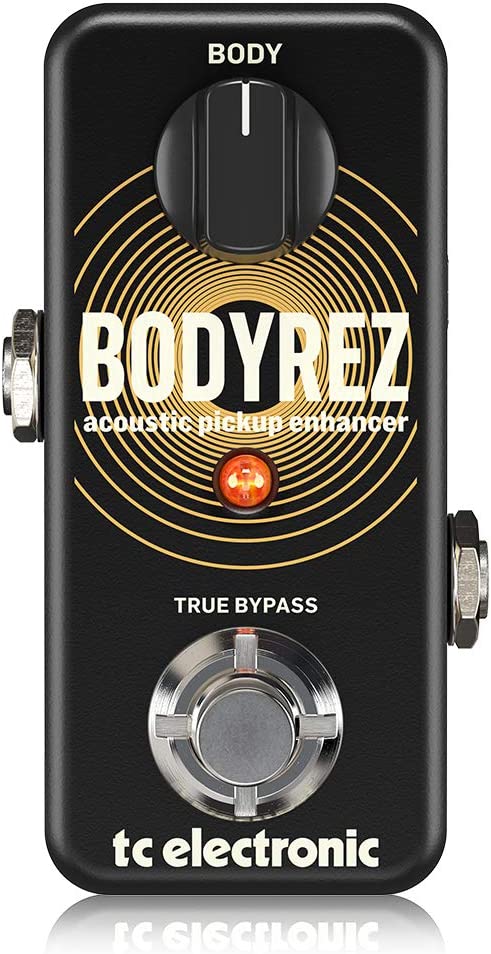
Equipped with a knack for amplifying acoustic guitar sound, the TC Electronic BODYREZ Acoustic Pickup Enhancer holds an impressive spot in the music world.
Tailored to eliminate those common acoustic pickup issues, it’s a real game-changer.
This device has a single knob, making it delightfully simple to use.
You turn it until your ears say yes; it’s as easy as that!
Adding a touch of studio-produced magic to your live performances, this small, compact gadget can be a musician’s best friend.
Feedback is never a pleasant experience, so the built-in feedback suppression feature is a major plus point.
Unplugged gigs need not be a worry anymore.
With its True Bypass design, signal integrity is never compromised during bypass.
This thoughtful design also means it won’t take up much real estate on your pedalboard.
And to top it off, it works smoothly with almost all pickups. Music to a guitarist’s ears, wouldn’t you agree?
- My Review
Taking the TC Electronic BODYREZ Acoustic Pickup Enhancer for a spin, it’s clear right off the bat that this device is not just an ordinary pedal.
My first impression was largely based on its compact, sleek design.
It’s hardly the size of a brick, but the weight of its influence on the guitar’s sound is a heavyweight contender.
Upon plugging in, one thing became evident: simplicity reigns supreme here.
Its one-knob interface is a testament to that, taking the stress out of operation.
You don’t need a degree in sound engineering to operate it; just a good ear and a discerning taste for tone.
Drawing a line under the days of subpar acoustic sound, the enhancer works its magic to deliver a studio-quality sound, even in live settings.
This is a feature that I, like many, truly appreciate—no need to suffer through an unplugged gig with a flat, lifeless sound.
Instead, the BODYREZ infuses your performance with depth and dimension.
Feedback? Not a concern.
The built-in suppression feature effectively tackles those annoying sound hiccups.
However, while this feature works well, having a bit more control over its parameters would be beneficial.
More customization could further elevate the user experience.
An undeniable asset is the True Bypass design.
Knowing your guitar’s pure, unaltered signal remains intact is a relief.
This feature also means that it won’t monopolize your pedalboard space, which can be a real plus for those with crowded setups.
A high degree of compatibility with the BODYREZ makes it a solid choice.
It doesn’t discriminate between pickups and works harmoniously with nearly all types.
This is a detail not to be overlooked, as it speaks volumes about its versatility.
So, does the TC Electronic BODYREZ Acoustic Pickup Enhancer live up to its hype?
Here are the ratings I’ll give to the TC Electronic BODYREZ Acoustic Pickup Enhancer:
I’d say it’s a resounding yes.
It’s not flawless, but it certainly earns its stripes in acoustic enhancement.
- Pros:
- Studio-quality acoustic guitar tone
- Built-in feedback suppression
- Restores natural playing feel
- Simple one-knob control
- Cons:
- Subtle effect may not suit everyone
- May not work well with all pickup types
- Some users experienced reliability issues
My final verdict is that the TC Electronic BODYREZ ACOUSTIC PICKUP ENHANCER is highly recommended for acoustic guitar players looking to enhance their tone and reduce feedback.
It offers a studio-quality acoustic tone, built-in feedback suppression, and the ability to restore the natural playing feel of your instrument.
While it may have some subtle effects that may not suit everyone, overall, it provides excellent performance and value for the price.
The positive customer reviews and the reputable brand of TC Electronic further support its quality and effectiveness.
Fender Acoustic Preamp/Reverb Pedal
Fender Acoustic Preverb delivers tailored preamp with reverb.
The Fishman Rare Earth Blend Acoustic Preamp offers a blend of microphone and pickup, reverb, built-in feedback suppressor and 3-band EQ for a tailored sound. Perfect for acoustic guitarists in the studio or on stage.
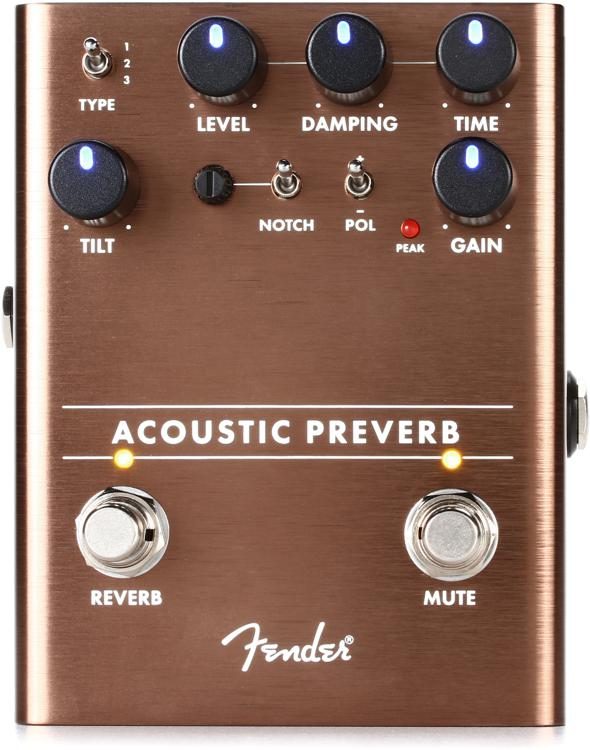
Meet Fender’s Preverb Pedal, an innovative device engineered especially for acoustic-electric guitar enthusiasts.
This pedal is not just about its visually pleasing exterior adorned in hues of brown, silver, and black; it’s about the functionality it brings to your fingertips.
It’s equipped with three unique reverb modes, allowing you to tweak and fine-tune your sound just as you desire.
Along with the reverb feature, you’ll find a nifty notch filter and a tilt EQ, both aimed at giving you superior control over your guitar’s tone.
Weighing in at a mere 0.85 pounds, it’s compact and highly portable with dimensions of 6 by six by 6 inches.
With Fender’s Preverb Pedal, you’re looking for a handy, versatile tool to amplify your acoustic guitar experience.
Here’s your chance to give your acoustic guitar an extraordinary tonal upgrade, courtesy of Fender.
- My Review
There’s something quite impressive about this little gadget.
Its sleek design, sporting shades of brown, silver, and black, is aesthetically appealing and an indication of the thoughtful engineering beneath.
On trying out this pedal, it’s clear that Fender has delivered a device with musician-friendly features.
What stands out right away is the versatility of the reverb options.
The three distinct modes provide an array of soundscapes to play with, a feature that I found quite intriguing.
Switching between the modes brought out the richness and depth of my acoustic guitar, enhancing its inherent qualities.
Speaking of tonal control, the pedal’s notch filter and tilt EQ were quite a revelation.
Their purpose is not immediately apparent, but after a while, it’s clear they offer fine-tuning capabilities that really can cater to the most discerning ears.
The notch filter helps eliminate unwanted frequencies, bringing out a cleaner, crisper sound.
The tilt EQ, on the other hand, makes adjusting the tone a breeze, something that any music enthusiast will appreciate.
Despite all these features, the pedal remains compact and portable.
It’s light, weighing just under a pound, which makes it a perfect companion for those on-the-go jam sessions or gigs.
Size-wise, it fits neatly into a standard pedalboard setup or even a backpack, making it easy to carry around.
Finally, the LED indicator on the pedal is a small but appreciated detail.
It’s a nod to convenience and visibility, especially useful during a dimly lit performance.
Although some may view this as a minor feature, for me, it underscores the thoughtfulness of the design.
Here are the ratings I’ll give to the Fender Acoustic Preamp/Reverb Pedal:
So, while the Fender Acoustic Preverb Pedal may initially seem like just another gadget in a musician’s arsenal, it is a valuable tool that can significantly elevate an acoustic-electric guitar’s performance.
It exemplifies Fender’s commitment to enhancing the acoustic playing experience, one pedal at a time.
- Pros:
- Enhances acoustic tone.
- Offers three reverb modes.
- Includes notch filter for better sound control.
- Compact and lightweight design.
- Cons:
- Limited color options (Brown, Silver, Black).
- No information on warranty coverage.
- Potential learning curve for beginners.
My final verdict is that the Fender Acoustic Preverb Acoustic Preamp/Reverb Pedal appears to be a versatile and feature-rich product that delivers excellent tone and performance.
With positive reviews highlighting its ability to enhance acoustic instruments and the reputation of the Fender brand, it holds promise for musicians seeking to optimize their acoustic-electric guitar setup.
While no negative reviews are available now, it’s important to consider potential drawbacks such as limited color options and the learning curve for beginners.
Additionally, without information on warranty coverage, it may be prudent to inquire about this aspect before purchasing.
Based on the provided information, the Fender Acoustic Preverb Acoustic Preamp/Reverb Pedal seems to be a solid choice for guitarists looking to enhance their acoustic tone with the convenience of a preamp and reverb pedal.
TC Electronic MojoMojo Overdrive Pedal
Authentic tube-amp sound with extra headroom and precise tone control.
MOJOMOJO OVERDRIVE delivers maximum mojo with increased circuit board voltage for extra headroom, precise tone controls, and a voicing switch to enhance your playing. It offers a lively and dynamic sound, allowing even the most subtle of licks to be heard.
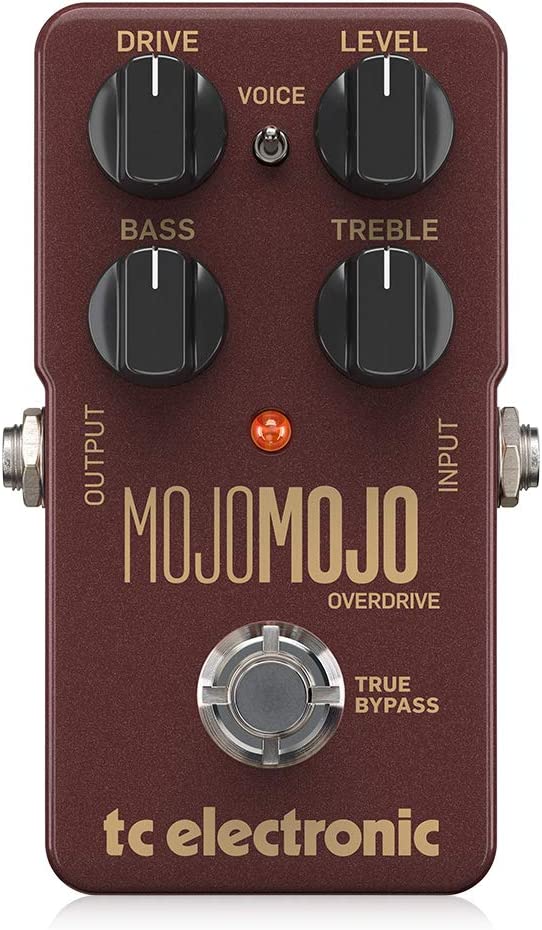
Looking at the TC Electronic MojoMojo Overdrive Pedal, this isn’t your run-of-the-mill equipment.
This pedal doesn’t just produce overdrive sounds; it allows full control of your sound with its drive, level, bass, and treble controls.
Thanks to its true bypass feature, you can say goodbye to tone loss, and that’s not all.
What sets this overdrive pedal apart is its voicing switch.
This neat feature provides a fantastic mid-shift, catering to all your tonal needs.
Dimensions-wise, it fits easily into any setup with its 5 x 3 x 4 inches size and light weight of only 0.22 kilograms.
This overdrive pedal is more than meets the eye, offering increased headroom and precise controls.
Its specially designed-circuit enhances the voltage and magnifies the dynamics and headroom, making your overdrive sound more alive than ever.
Down to the subtlest note, it’s a great tool for players who want their performance to shine through.
- My Review
Having put the TC Electronic MojoMojo Overdrive Pedal through its paces, I found it to be an impressive piece of gear.
First off, its size and weight make it a practical addition to any setup.
Despite its compact design, it delivers a substantial, full-bodied sound, courtesy of its meticulous drive, level, bass, and treble controls controls.
It’s like having a mini control station for your overdrive sounds.
One standout feature for me is the true bypass.
This isn’t just a fancy add-on; it preserves your tone, maintaining its purity and clarity.
That’s a serious advantage for any pedal, especially for discerning musicians who want to keep their sound as true to its source as possible.
But where the MojoMojo shines is in its voicing switch.
This little feature works wonders for your sound’s midrange, allowing you to customize it to your liking.
So, this pedal covers you whether you prefer a full-bodied, warm tone or a bright, cutting sound.
An important aspect that deserves mention is the pedal’s exceptional overdrive.
It offers remarkable headroom thanks to its unique voltage-enhancing circuit.
Instead of over-the-top distortion, this pedal uses increased voltage to boost its dynamic range.
The result is an overdrive sound that’s incredibly alive and responsive.
Plus, the precise controls mean you can fine-tune your sound how you like it.
Despite all its high points, I found the tone controls require some attention.
But once you’ve spent time with the MojoMojo, navigating its range of sound options becomes a breeze.
Here are the ratings I’ll give to the TC Electronic MojoMojo Overdrive Pedal:
In my book, the TC Electronic MojoMojo Overdrive Pedal is a powerful tool for any musician, blending usability with a diverse sonic palette.
It’s not just about the overdrive – it’s about giving you the freedom to craft your unique sound.
- Pros:
- Amplifier-like sound
- High headroom and dynamics
- Precise tone controls
- Cons:
- Large size
- Relatively high price
- No battery operation (requires power supply)
My final verdict is that the TC Electronic MojoMojo Overdrive Pedal is a highly versatile and feature-rich option that delivers exceptional tone and performance.
With its amplifier-like sound, high headroom, precise tone controls, and the added voicing switch, it offers a wide range of overdrive possibilities.
The brand TC Electronic is well-known for producing quality musical equipment.
However, considering its larger size, relatively higher price, and the need for a power supply, it may not be the most suitable choice for everyone.
Nevertheless, for guitarists seeking a pedal that captures the essence of cranked tube amp overdrive, the MojoMojo pedal offers a compelling option.
L.R. Baggs Align Delay Acoustic Guitar Effects Pedal
Add dynamic depth with the L.R. Baggs Align Delay Effects Pedal.
This dual-pickup system adds versatility to electric guitars, blending active and passive pickups for a unique sound. The pre-wired control plate makes installation easy, while diagrams and a battery clip ensure proper wiring.
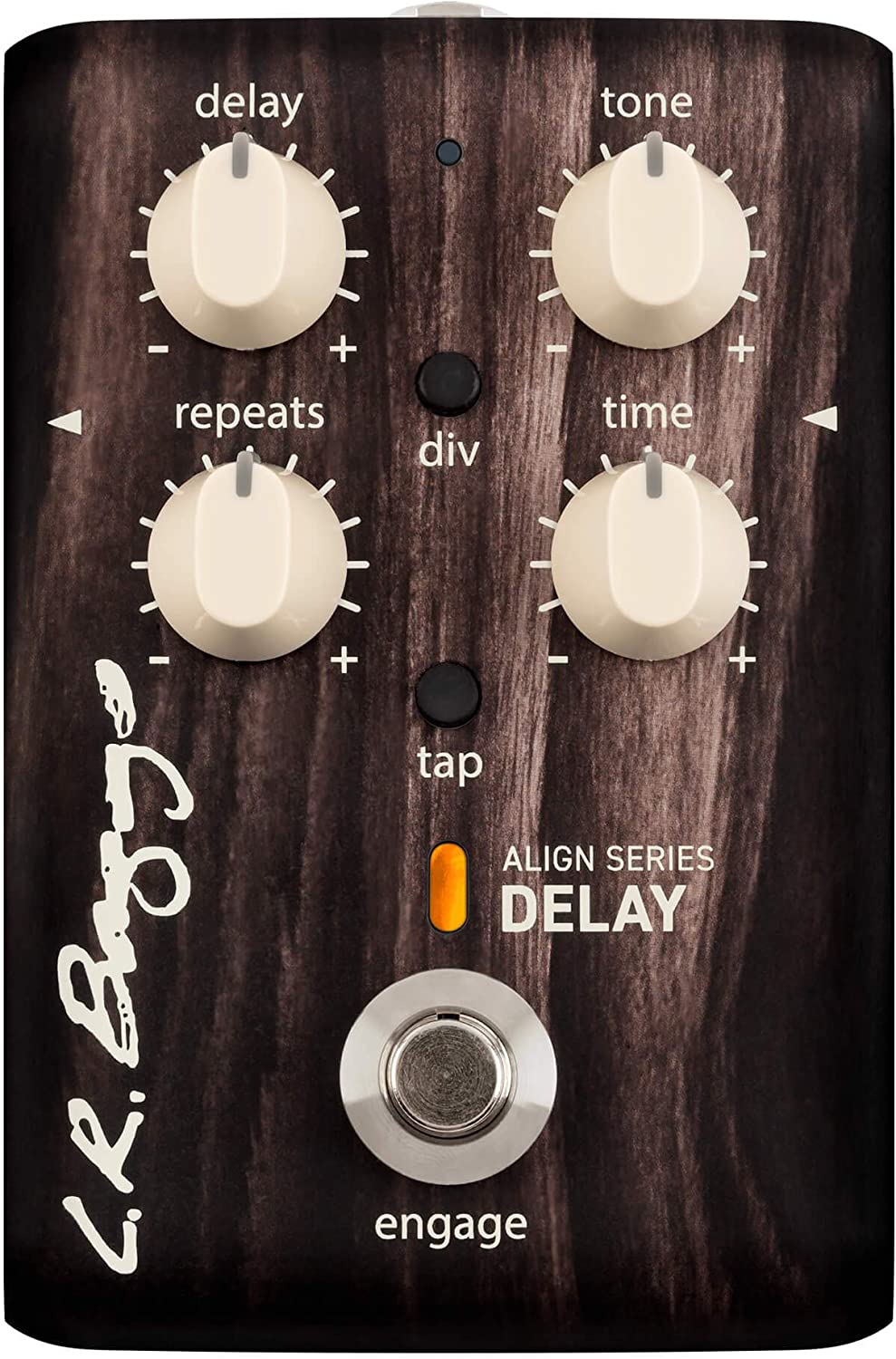
With the L.R. Baggs Align Delay Acoustic Guitar Effects Pedal, musicians can imbue their performance with a unique depth.
The magic lies in the Delay Control, a clever feature that marries the unaffected and delayed signal, resulting in a perfectly balanced sound.
Alongside this, the total number of repeats is effortlessly manipulated with the aptly named ‘Repeats’ knob, granting you extensive creative freedom.
Flexibility also extends to Time Control, enabling you to dictate the delay between the original and repeated signal.
With this, each strum can reverberate to your exact specifications.
Moreover, with a sweeping Tone Control, you can dial in a wide spectrum of sound quality, from cozy warmth to striking clarity, catering to all your tonal desires.
An intriguing feature called ‘Division’ also allows you to match the delay to the dotted eighth note of your current tempo.
This alignment tool complements your rhythm, bringing a multidimensional flair to your acoustic performance.
- My Review
Playing around with the L.R. Baggs Align Delay Acoustic Guitar Effects Pedal, it quickly becomes evident that this isn’t your ordinary effects pedal.
It injects a whole new depth into your performances, opening up a world of creative possibilities.
Immediately, the Delay Control captures your attention.
It expertly blends the delayed signal with the original, producing an incredibly balanced sound.
It doesn’t overshadow your playing but enhances it, adding a beautiful echo that feels natural and impactful.
Next, there’s the ‘Repeats’ feature. Talk about freedom of expression!
You can tweak the number of repeats to suit your specific musical style, and it’s surprisingly responsive.
One moment, it’s a subtle echo; the next, it’s a wave of resonant sound.
It’s a lot of fun to play with; I have to admit.
Onto the Time Control. Here, you set the gap between the original signal and its repeat.
It’s easy to underestimate this feature but trust me, it’s a game-changer.
The degree of control over the timing is phenomenal, allowing you to dictate how your strums reverberate incredibly intuitively.
The Tone Control, this little knob, is about dialing in your sound.
Want something warm and inviting? It’s there.
Are you craving clarity and precision? It’s got you covered.
The impressive range makes it a versatile tool for shaping your acoustic output.
Finally, the ‘Division’ feature sets the delay to the dotted eighth note of your current tempo.
This may seem a bit niche, but it offers an intriguing way to layer your sound and add unique rhythmic complexity to your playing.
- Pros:
- Compact and portable design
- Flexible delay control
- Wide range of tone options
- Cons:
- Limited number of repeats
- May not suit all musical styles
- Higher price compared to other pedals
So, my take on this pedal? It’s an inventive gear that offers plenty of flexibility and control.
Sure, it might take some getting used to, but once you’ve got the hang of it, it can take your performance to a new dimension.
Here are the ratings I’ll give to the L.R. Baggs Align Delay Acoustic Guitar Effects Pedal:
My final verdict is that the L.R. Baggs Align Delay Acoustic Guitar Effects Pedal is a versatile and feature-rich product with excellent tonal capabilities.
Its performance is commendable, and the reputable brand behind it adds to its appeal.
However, the slightly higher price may impact its overall value proposition.
Ultimately, it would be wise to consider individual requirements and compare them with other options before making a final decision.
Wampler Ego Compressor V2 Guitar Effects Pedal
Compress, control, and enhance tone with Wampler’s Ego Compressor V2.
The Wampler Ego Compressor V2 offers compression effects with adjustable sustain, tone, blend, and attack controls, allowing you to create a wide range of sounds from subtle tone sweetening to classic ‘chickin’ pickin.’ Its blend control acts as a mixer knob, allowing you to mix in clean, uncompressed signal.
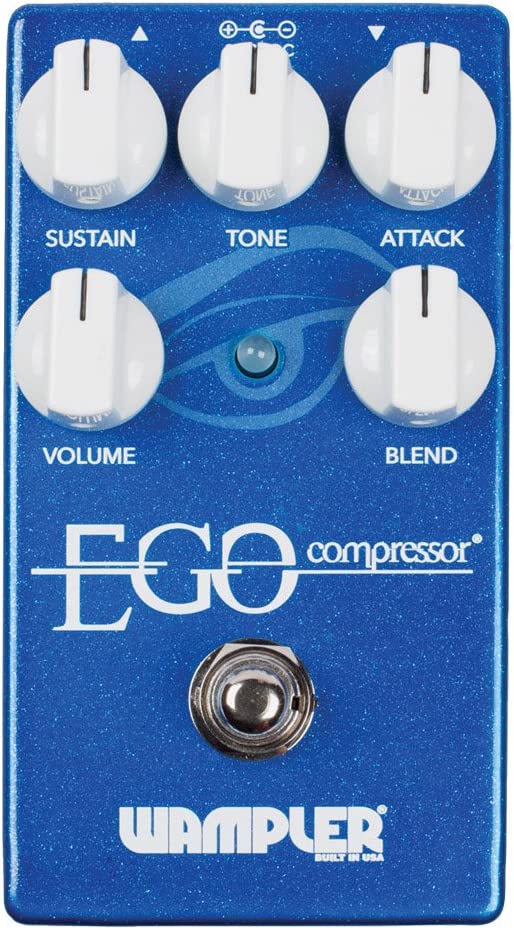
With the Wampler Ego Compressor V2, you can expect a guitar effects pedal that delivers extraordinary control tailored to the needs of today’s musicians.
Its unique design maintains your playing dynamics without altering the original tone.
The pedal offers an option to mix in your raw signal, which means you get the compression advantages without the upfront squash.
This versatile gear offers everything from the full squash typical of country music to a more subtle, studio-level parallel compression.
It’s equipped with a range of controls, making it suitable as an always-on compressor or as an effect for specific parts of your performance.
In a nutshell, this pedal’s flexibility ranges from smooth, sustained notes to more driven, compressed sounds.
Be it for fattening up your rhythms or providing a controlled edge to your solos; this pedal has got you covered.
The Ego Compressor V2 is an innovative tool for guitarists looking for a pedal that will respect their tone while adding something special to their sound.
- My Review
Using the Wampler Ego Compressor V2 feels like unlocking a new range of tonal possibilities.
With an arsenal of dynamic controls, this pedal empowers you to tailor your sound precisely.
Adaptable is the word that first comes to mind.
You can switch between full country-style squash and studio-level parallel compression to craft your sound for every setting.
What sets it apart is the ability to blend in your original signal, giving you the perks of compression while preserving the essence of your tone.
Right out of the box, the Ego Compressor V2 impresses with its sleek design and sturdy build.
It’s pedal you can trust to withstand those impassioned performances and long studio sessions.
Now, onto its core features.
The sustained control is truly a highlight.
It gives you the power to dictate the duration of your notes, creating space for passionate, lingering solos or sharper, rhythmic lines.
However, you must be cautious as cranking it up too high can raise the noise floor, interfering with your desired sound.
The Tone knob is an unexpected yet welcome feature.
It allows you to add extra sparkle and presence to your sound, dialing in the exact amount of brightness you want.
However, the Blend functionality truly makes the Ego Compressor V2 unique.
This feature gem works as a mixer knob for your compressed and clean signals, allowing you to create a perfectly balanced sound.
Regarding limitations, it’s worth noting that the compression effect can seem a bit subtle for some preferences.
But with patient tweaking, you can strike the right balance that works for you.
Here are the ratings I’ll give to the Wampler Ego Compressor V2 Guitar Effects Pedal:
In my experience, the Wampler Ego Compressor V2 is an excellent companion for anyone looking to fine-tune their guitar sound.
Its remarkable flexibility and the control it offers make it a valuable addition to any pedalboard.
- Pros:
- Flexible and transparent compression
- Retains playing dynamics without coloring tone
- Allows blending of original signal
- Versatile for different compression styles
- Comprehensive array of controls
- Cons:
- Potential learning curve for optimal settings
- May introduce slight increase in noise floor
- Relatively higher price compared to other compressors
My final verdict is that the Wampler Ego Compressor V2 Guitar Effects Pedal is an excellent choice for guitar players seeking a versatile, transparent, and feature-rich compressor.
Its ability to retain playing dynamics, blend the original signal, and enhance tone with precise control offers great flexibility.
The pedal’s performance and brand reputation are strong, delivering a high-quality and reliable product.
While it may have a slight learning curve and a relatively higher price point, its overall value remains competitive.
I highly recommend the Wampler Ego Compressor V2 for guitarists looking to enhance their playing dynamics and achieve a professional sound.
Boss DD-500 Digital Delay Pedal
Powerful, customizable digital delay with 12 modes and Version 2 software enhancements.
The BOSS DD-500 is an advanced digital delay pedal with 12 versatile delay modes, deep editing controls, a graphic display, patch memories, MIDI, and real-time assignable control for unparalleled sound-creation and live performance flexibility. It offers high-end audio quality with analog pass-through and buffered or true bypass options. Version 2 software adds even more features for increased performance and sonic possibilities.
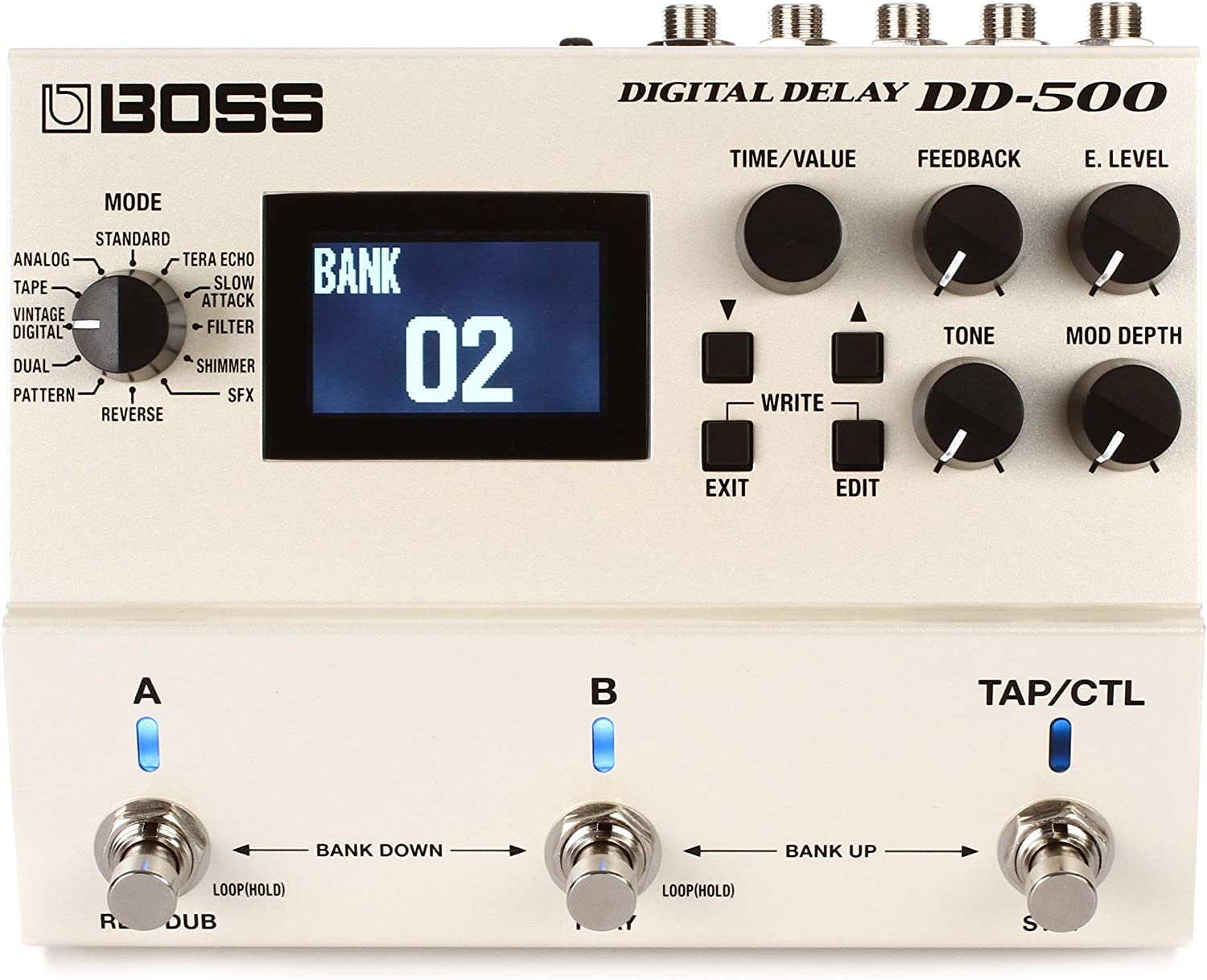
Boss’s DD-500 Digital Delay is a powerhouse among stompbox delays, packed with innovative BOSS technology.
It’s a versatile tool for musicians, delivering a wide array of delay modes, 12 in total, ranging from vintage to modern.
Each mode can be further tweaked using a semi-parametric four-band EQ, modulation, ducking, and other parameters.
The device boasts a robust 32-bit/96kHz processing capability, ensuring top-notch sound quality for every effect.
It allows for a choice between buffered and true-bypass operation.
For those keen on precision, the pedal also offers deep editing controls, complemented by a graphic display.
A noteworthy aspect is its practical usability, enhanced by a large, integrated LCD.
It provides clear visibility of delay time, patch ID, and more.
The DD-500 can also connect to a computer via USB for remote editing and patch backup.
It’s even MIDI-compatible, opening up additional control options for advanced setups.
The physical specifications include dimensions of 10.1 x 8 x 4.6 inches, weighing 998 grams.
Its outer shell, predominantly white, is sturdy, typical of the Boss brand.
- My Review
Regarding immersive sound experiences, the Boss DD-500 Digital Delay pedal checks all the boxes.
Having spent time exploring its vast array of features, I find it provides an impressive balance of classic tones and cutting-edge sounds.
Honestly, this piece of gear exceeded my expectations.
Let’s start with the 12 distinct modes, each offering a unique echo effect.
There’s no denying the versatility here.
I got lost playing around with the vintage echoes, tape-based analogs, and modern digital delays – all easy to control and adjust to your taste.
What also struck me was the top-tier sound quality.
That 32-bit/96kHz processing isn’t just a number on a spec sheet.
You can hear the difference; it’s crystal clear, lending a professional touch to your music.
Thanks to the comprehensive display, I appreciate how easy the DD-500 is to operate.
It provides useful, at-a-glance information, and the menu is surprisingly intuitive, simplifying switching between modes and tweaking parameters.
Yet, for all its incredible sound options, the DD-500 is not without its challenges.
It’s a deep piece of equipment with many parameters to adjust, which could overwhelm those new to digital delays.
And while the built-in screen is handy, navigation can be tricky until you get the hang of it.
I also connected the pedal to my computer using the USB port.
It allowed me to dive deeper into the settings, a great feature for all you sound-tweaking enthusiasts.
Remember, though, this might not be everyone’s cup of tea.
One can’t ignore the MIDI compatibility, a great plus for those with advanced rigs.
It adds a layer of control that could be a game-changer in live performances or recording sessions.
Physically, the pedal is durable, showing no wear and tear, typical of Boss’s reputation.
However, its weight and size make it less portable than other pedals.
It’s a trade-off for the multitude of features packed into it.
Here are the ratings I’ll give to the Boss DD-500 Digital Delay Pedal:
Boss’s DD-500 is a worthy investment if you’re after top-notch sound quality, versatility, and in-depth control.
It might take time to exploit its potential fully, but the rewards are worth the learning curve.
- Pros:
- Wide range of delay options.
- Customizable control settings.
- High-quality sound and audio processing.
- Easy patch saving and editing.
- Supports analog pass-through.
- Cons:
- Some users may find the user interface unfamiliar.
- Bypass switches may pose positioning challenges on pedalboards.
- Not true stereo despite independent connections.
- No power supply included.
- Extensive parameter tweaking can be time-consuming.
My final verdict is that the Boss DD-500 Digital Delay is a highly versatile and feature-rich pedal that delivers exceptional tone and performance.
Its customizable control settings, a wide range of delay options, and intuitive user interface offer musicians a powerful tool for creating unique delay effects.
The brand reputation of Boss further adds to its appeal, while the value provided by the pedal’s capabilities is commendable.
However, some users may find the user interface unfamiliar, and the absence of a power supply could be a drawback.
Overall, the Boss DD-500 Digital Delay is a top contender in digital delay pedals, offering a vast array of creative possibilities.
Wet Dreams Analog Chorus Effect Pedal
Lush analog chorus for dreamy soundscapes.
Analog Chorus by Deadbeat Sound offers dreamy, wet effects to your guitar and bass. It has true bypass funtionality, is very small, compact, and when it comes to control knobs, you’ll find Depth, Speed and Level knobs to make your instrument sound however you’d like.
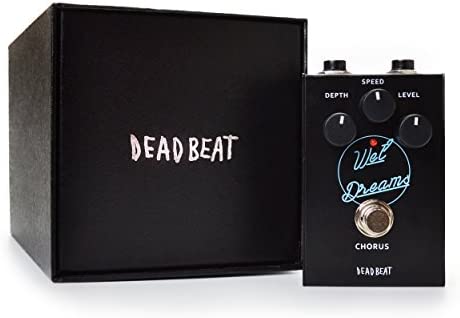
Introducing the Wet Dreams Analog Chorus Effect Pedal, a stellar creation by Deadbeat Sound that breathes life into your music.
Imbued with a timeless analog chorus mechanism, it’s built to refine your tone, lifting your highs to crystalline purity and rounding out your lows with a robust simmer.
Uniquely compact in design, its dimensions measure just 60mm in width, 96mm in depth, and 55mm in height, a pocket powerhouse.
Deadbeat Sound places immense control in your hands with its trio of knobs – depth, speed, and level, each contributing to your ultimate sound output.
No compromises are made on the sound integrity, thanks to the pedal’s true bypass feature, which preserves your tone.
It operates on a 9-volt power source and draws a current of 200 milliamps.
Please note, however, that this new product iteration doesn’t come packaged with a power supply or patch cables.
Nevertheless, it is a remarkable tool for musicians looking for that rich and lush textural chorus in their sound.
- My Review
My journey with the Wet Dreams Analog Chorus Effect Pedal, created by Deadbeat Sound, has been mesmerizing.
The product’s soulful character was apparent when I plugged it in.
It’s not just a pedal; it’s an extension of my musical voice.
Its compact size was my first surprise; it doesn’t hog up precious pedalboard real estate.
Yet, it delivers a power that belies its dimensions.
The true analog chorus at its heart is impressive, delivering a clean, classic tone ranging from shimmering highs to brooding lows.
It’s as though the Wet Dreams pedal layers my sound with a rich texture, an almost liquid quality, that is distinct yet seamless.
Controls on this pedal are intuitive and responsive, providing a fine-tuned musical palette at my fingertips.
The depth, speed, and level knobs respond precisely, making dialing in just the right chorus effect easy.
With these controls, I feel I can sculpt my sound rather than tweak it.
Running on a standard 9-volt power source, it’s easy to integrate into any setup.
Yet, it’s important to note that it’s quite the power guzzler, pulling a hefty 200 milliamps.
Be sure to have a capable power supply on hand!
There’s just one bone to pick – the omission of a power supply and patch cables in the package.
For a product of this caliber, it feels like a slight oversight.
But once you look past this small hiccup, the Wet Dreams pedal truly sings.
Here are the ratings I’ll give to the Wet Dreams Analog Chorus Effect Pedal:
Deadbeat Sound has crafted the Wet Dreams Analog Chorus Effect Pedal with a blend of thoughtful design and excellent engineering.
For any musician seeking that distinct chorus effect, this pedal might be the missing piece in your sonic jigsaw.
- Pros:
- Classic chorus sound.
- Compact size.
- Depth, speed, and level control.
- Cons:
- No power supply and patch cables included.
My final verdict is that the WET DREAMS Analog Chorus Effect Pedal by Deadbeat Sound is a solid choice for musicians seeking a classic chorus sound in a compact size.
With its versatile features, excellent tone, and reliable performance, it delivers on its promises.
However, the absence of a power supply and patch cables may be a drawback for some users.
Considering its brand reputation and overall value, it is a commendable product with a 4 out of 5 score.
Boss AD-2 Acoustic Preamp Pedal
Acoustic preamp pedal for a natural sound, resonance control, and being stage-ready.
The AD-2 Acoustic Preamp Pedal offers acoustic-electric guitarists natural, studio-quality sound for live performances. Equipped with an advanced BOSS sound engine, this compact pedal delivers sophisticated processing and an intuitive interface. Acoustic Resonance reproduces your unplugged tone, while Ambience adds pro-level reverb. With essential stage tools like a feedback-controlling notch filter, a balanced DI out for PA connection, and a mute function, the AD-2 is perfect for any stage.
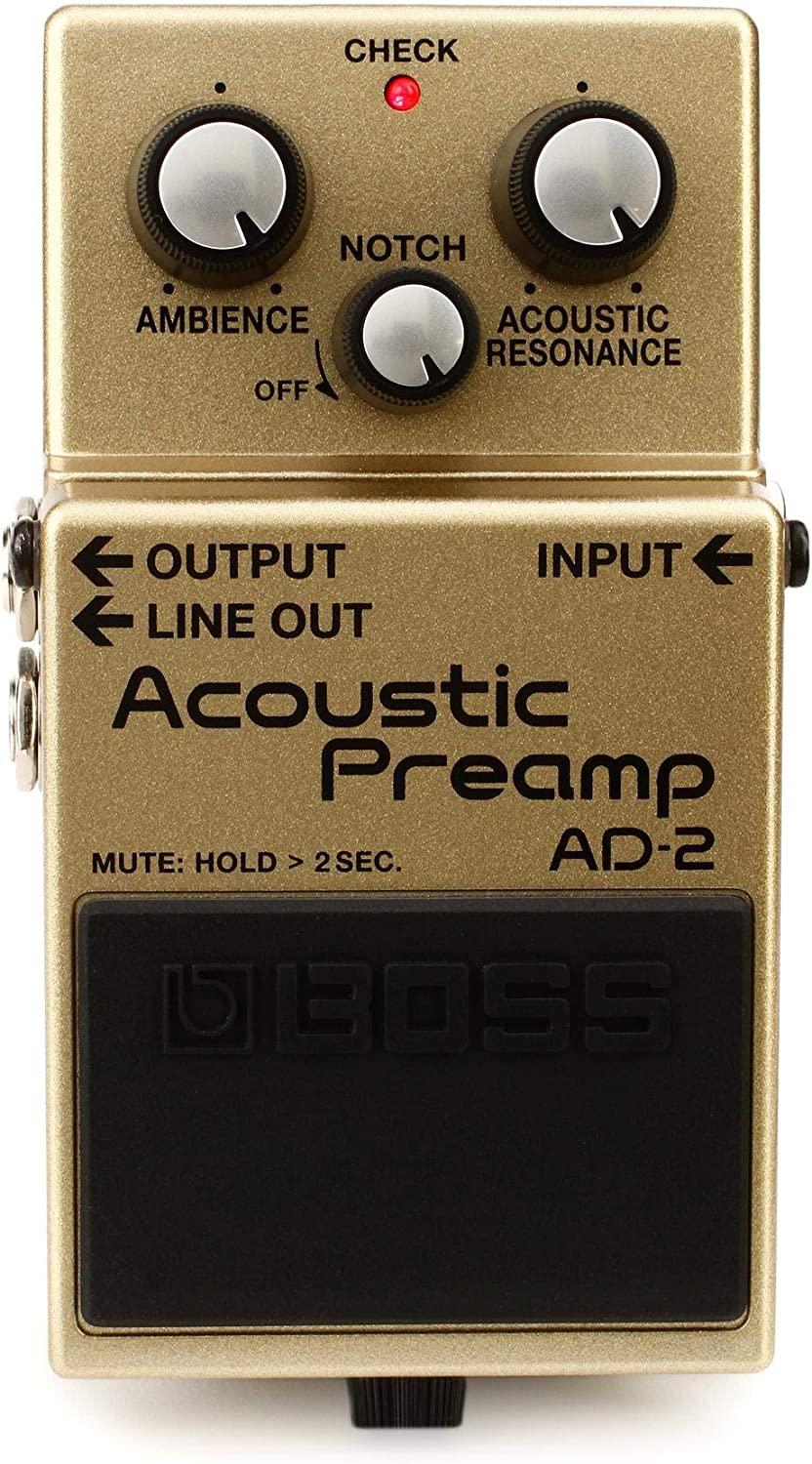
Let’s take a look at the Boss AD-2 Acoustic Preamp Pedal.
This handy piece of kit is designed with the specific needs of the acoustic guitarist in mind.
It harnesses advanced BOSS sound processing to reproduce the complex tonal characteristics of an unplugged acoustic.
What stands out about the AD-2 is its Acoustic Resonance feature.
This is essentially the pedal’s soul, perfectly replicating the rich, deep resonance of an acoustic guitar being played live.
You also get an onboard reverb that that’s specifically for acoustic guitar.
Its sound is a simple echo and a lush, warm, and spacious ambiance that enhances your guitar’s voice.
In addition to the above, the pedal provides a handy notch filter.
This feature is excellent at taming any feedback issues you encounter on stage.
Finally, the pedal boasts a straightforward interface, making it intuitive and easy to navigate even during a live performance.
It’s a coIt’shensive tool that acoustic guitarists would undoubtedly find beneficial.
- My Review
Let’s dive into my experience with the Boss AD-2 Acoustic Preamp Pedal.
The pedal’s sleek design and intuitive interface impressed me off the bat.
This was a big thumbs-up for musicians like me who value aesthetics and ease of use.
Strapping in my acoustic and firing up the AD-2, the Acoustic Resonance feature caught my attention.
It didn’t merely add some reverb to my strums; it brought out the depth, warmth, and nuance you’d expect from a finely crafted acoustic guitar echoing through a high-ceilinged hall.
This effect, tailored for the acoustic guitar, was a remarkable nod to authenticity.
Now, about the onboard reverb – this isn’t your run-of-the-mill echo effect.
It added a lush, spacious ambiance to my playing, taking the sonic landscape to a new level.
My guitar’s voice, as unique as it is, found new ways to express itself.
Despite my appreciation for these features, I have a bone to pick.
The Acoustic Resonance feature was a bit of a one-trick pony.
While it enhanced the sound remarkably well, it lacked some versatility, mainly if you have a particular tonal flavor.
However, let’s not overlook the included notch filter – a savior on stage to control feedback.
It worked like a charm, helping maintain the integrity of my performance without any unwanted noise.
The Boss AD-2 stands out for its commitment to acoustic authenticity in my book.
It’s not perfect, but its nuances to your sound can elevate your performance.
Here are the ratings I’ll give to the Boss AD-2 Acoustic Preamp Pedal:
It’s like having a sound engineer in a box, ready to help your acoustic guitar shine.
Whether you’re a hobbyist or a stage regular, this could be a valuable addition to your gear.
- Pros:
- Natural acoustic sound reproduction.
- Studio-quality reverb.
- Flexible performance outputs.
- Effective notch filter for feedback control.
- Improves sound through PA systems.
- Cons:
- Possible EQ adjustments needed for standalone use.
- May not suit all guitar setups equally.
- Potential volume and tone limitations.
My final verdict is that the Boss AD-2 Acoustic Preamp Pedal is a versatile and feature-rich option for acoustic-electric guitarists.
It provides natural acoustic sound reproduction, studio-quality reverb, and essential performance tools like the notch filter for feedback control.
The brand reputation of Boss adds to its credibility, and it offers good value for the price.
While some adjustments may be needed for standalone use, and there might be minor limitations in volume and tone, overall, it is a reliable choice for enhancing acoustic guitar tone and performance.
NuX Stageman Floor Acoustic Preamp and DI Pedal
NUX Stageman Floor: Analog preamp with digital effects and looper for natural clarity and versatile preamp connections.
NUX Stageman Floor is an intuitive analog acoustic preamp with digital effects and looper function, providing natural sound with adjustable 3-band EQ, notch filter and input gain control. It features one-knob control for chorus and reverb effects, and a freeze effect activated when the chorus switch is pressed and held. It is suitable for various acoustic instruments with versatile preamp settings and FX Loop input.
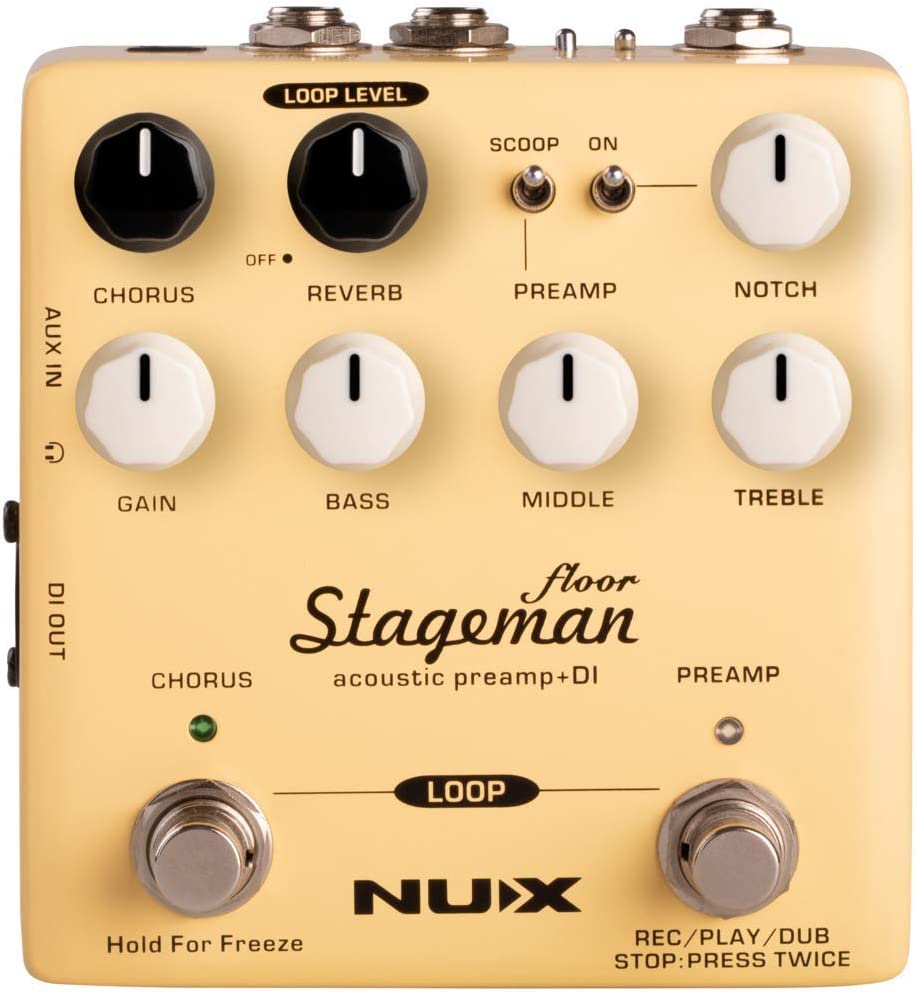
This NuX Stageman Floor pedal is a comprehensive toolkit for the acoustic musician.
A hallmark of this device is its unique blend of analog and digital technologies.
For instance, the preamp utilizes analog processing to maintain the authentic tonal quality of your instrument.
At the same time, the effects, such as reverb and chorus, are digitally controlled for ease and precision.
The middle-frequency scoop switch and adjustable notch filter are useful tools for tailoring your sound, giving you control over troublesome frequencies.
Designed with flexibility, this pedal allows you to select an input set that matches your guitar’s pickup type – whether piezo or magnetic.
The added looping function offers 60 seconds of recording time with limitless overdubs, a fantastic feature for layered, solo performances.
Connection-wise, it has various options, including XLR DI output, TRS send/return inputs, and aux-in and headphone-out ports.
This pedal isn’t just for guitarists; it’s equally suited to other acoustic instruments such as violins, mandolins, and banjos.
With its robust feature set and versatile connections, the Stageman Floor is a companion for any acoustic musician.
- My Review
From my experience with the NuX Stageman Floor, this gear is more than just a simple acoustic preamp and DI pedal.
Diving into its features, I found it to blend analog and digital technologies, delivering warmth and clarity.
Personally, its 3-band EQ with mid-scoop toggle gave me incredible control over my tone.
It’s like having a mini sound engineer at my feet!
One aspect that struck me was the pedal’s effects.
Controlling the reverb and chorus with a single knob is surprisingly effective.
When I cranked it up from 0 to 10, I was greeted with a series of balanced adjustments that resulted in a delightful blend of ambiance.
At the heart of the Stageman Floor is its looper function.
What a delight!
It gave me 60 seconds of recording with unlimited overdubs, allowing me to create multi-layered sonic landscapes independently.
The transformation from a simple pedal to a performance powerhouse was quite impressive.
Playing around with the input optimization, I found switching between piezo and magnetic pickups extremely beneficial.
Not only does it offer better signal processing, but it also makes the Stageman Floor versatile enough to work with a broad range of acoustic instruments.
I enjoyed using it with a violin and a banjo, and it performed admire overall.
The pedal’s build felt sturdy and reliable, coming in three color variants: silver, cream-white, and black.
Each added a touch of aesthetics that I appreciate.
Yet, if I were to point out a critique, I would love more control over the effects parameters.
Despite that, I was satisfied with how easy it was to dial in a good tone.
Here are the ratings I’ll give to the NuX Stageman Floor Acoustic Preamp and DI Pedal:
To wrap it up, the NuX Stageman Floor offers a unique and versatile toolset that enhances the experience of an acoustic musician.
Although it could benefit from more precise effects control, it remains a solid, practical choice for those needing a multifunctional pedal.
- Pros:
- Compact and portable design.
- High-quality effects with one-knob control.
- Versatile preamp for different pickup types.
- Includes a 60-second looper function.
- Cons:
- Limited color options (Silver, Cream White, Black).
- No built-in tuner feature.
My final verdict is that the NuX Stageman Floor Acoustic Preamp and DI Pedal is an excellent choices for musicians seeking a compact and versatile solution for acoustic amplification.
Its high-quality effects, one-knob control, and versatile preamp options offer a wide range of tonal possibilities.
The inclusion of a 60-second looper function further enhances its appeal.
While it may have limited color options and lacks a built-in tuner, its overall performance, brand reputation, and value make it a highly recommended product in its category.
Strymon Flint Tremolo and Reverb Pedal
Versatile tremolo/reverb pedal with amp-like tones.
This pedal offers classic amp-style tremolo and reverb in a single, easy-to-use stompbox with stereo inputs and outputs. Intuitive controls allow you to adjust the depth and speed of the tremolo and the amount of reverb, and a wet/dry mix and expression pedal input are included.
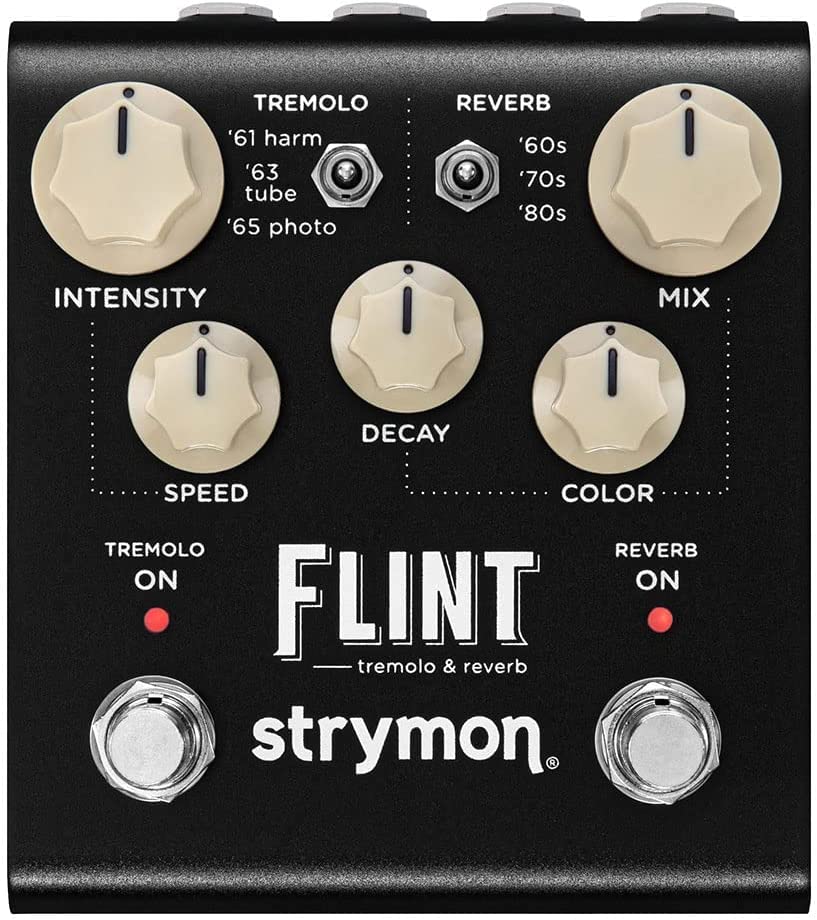
Crafted by Strymon, this nifty pedal named the Flint Tremolo and Reverb V2 is an ace up your sleeve for any musician, offering an array of distinctive and high-quality sound effects.
Being a combination of tremolo and reverb, it bestows upon you three exclusive modes, enhancing your creative latitude while keeping the footprint on your pedalboard compact.
Brought to life in a stylish black and white design, the pedal boasts 7.9 inches in length, 4.5 inches in width, and a height of 3.7 inches.
Weighing in at just 1.38 pounds, its lightweight nature ensures that it won’t add much heft to your gear.
This powerhouse also facilitates an expression pedal input, a fantastic attribute allowing you to control real-time parameters for a more dynamic performance.
Its stereo Input/Output functionality is primed to provide an amp-like sonic experience, embodying the spirit of your favorite classic guitar amplifiers.
- My Review
Diving into the world of Strymon’s Flint Tremolo and Reverb V2 pedal, I was immediately struck by its visual appeal.
Designed in contrasting shades of black and white, its compact build exhibits elegance, disguising the mammoth capabilities within its minimal footprint.
Weighing a scant 1.38 pounds, its lightweight nature is a boon, allowing it to be a comfortable addition to my gear without tipping the scales.
I plunged into its various offerings, intrigued by the three tremolo and reverb modes.
And I wasn’t disappointed.
Each mode had its unique character, allowing me to shape my sound with a level of precision that’s both refreshing and exciting.
Every tweak felt impactful, carving out the acoustic space around the notes with finesse.
Plugging in an expression pedal unveils a new level of dynamic control.
The real-time parameter shifts lent a fluidity to my sound, making the performance feel more alive and responsive.
Its stereo I/O presented a vast and immersive sound stage, echoing the rich, spacious reverbs and pulsating tremolos I remember from my favorite vintage amps.
Despite my appreciation for the Flint V2, its cost initially gave me pause.
Yet, once I experienced its sonic offerings, the price tag seemed justified.
Instead of buying two high-quality pedals for tremolo and re overall, this one offered me both in a single package.
But it’s not just about cost-effectiveness; it’s about the pedal’s versatility, convenience, and top-notch performance.
Indeed, the Flint V2 is a superbly engineered piece of gear.
Here are the ratings I’ll give to the Strymon Flint Tremolo and Reverb Pedal:
It might demand a bit of an investment, but considering its features, flexibility, and the beautiful sounds it produces, I’d say it’s well worth it.
Every time I step on it, it reaffirms its value and my choice to add it to my setup.
- Pros:
- Compact size.
- Three tremolo modes.
- Expression pedal input.
- Three reverb modes.
- Stereo I/O.
- Cons:
- No negative reviews available currently.
My final verdict is that the Strymon Flint Tremolo and Reverb Pedal V2 is an excellent choice for guitarists seeking a compact and versatile pedal.
With its three tremolo modes, expression pedal input, three reverb modes, and stereo I/O, this pedal offers a wide range of features to enhance tone and performance.
The positive reviews from satisfied customers further validate its quality and value.
While no negative reviews are currently available, it’s important to consider individual preferences and needs when purchasing.
Overall, the Strymon Flint Tremolo and Reverb Pedal V2 are top-notch options for guitarists looking to add amp-like tremolo and reverb effects to their pedalboard.
MOOER Acoustic Guitar Effect Pedal
Classic optical compression in a durable, space-saving pedal.
The Mooer Yellow Comp Optical Compressor is a classic optical compressor pedal with smooth attack and decay. It preserves tone without coloring, and features a full metal casing and true bypass for durability.
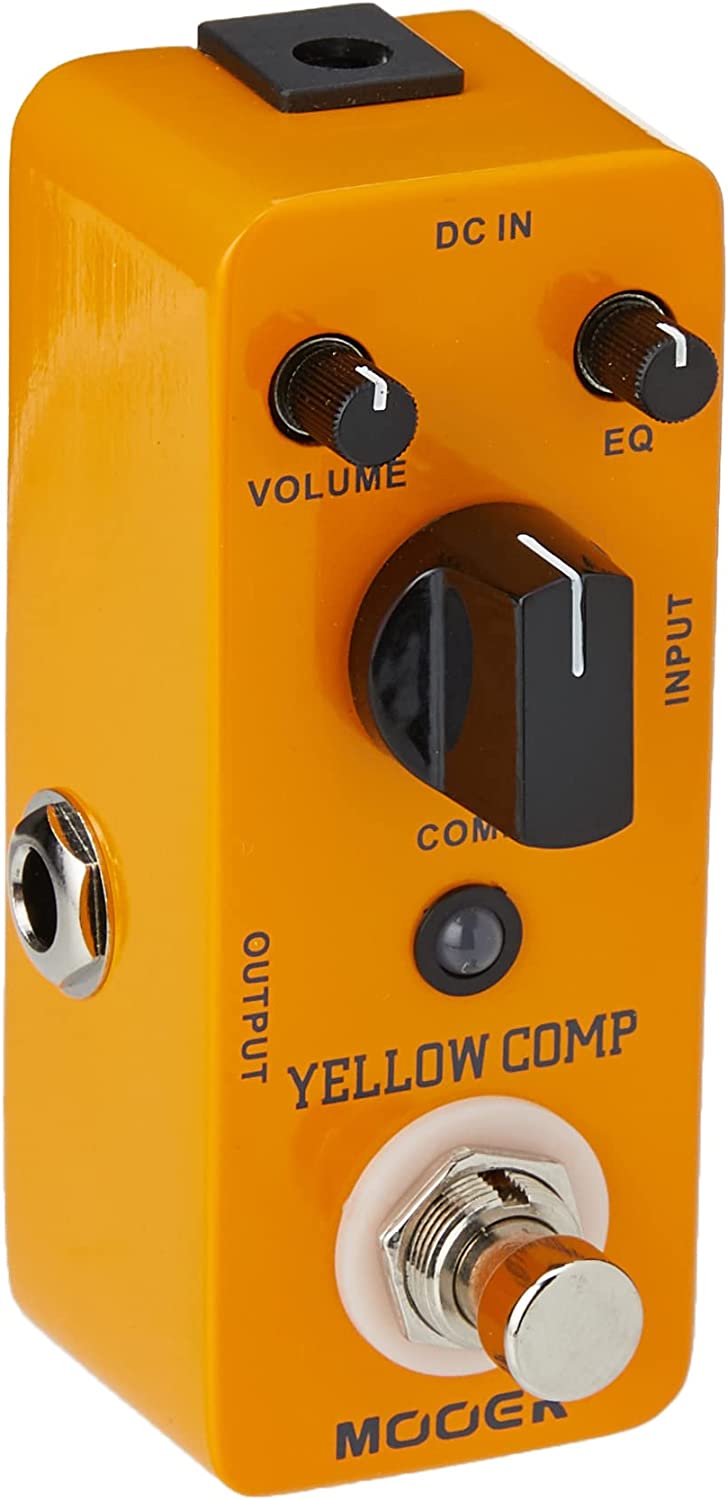
Crafted for acoustic guitars, the Yellow Comp from MOOER is more than just an effect pedal.
This neat, pocket-sized unit packs a powerful punch, offering classic optical compression that ensures your guitar’s original signal transients stay intact, meaning your tone doesn’t get colored or distorted.
This petite powerhouse is a real space-saver on your pedal board, measuring 1.75 x 4.25 x 2.25 inches and weighing just 0.16 kilograms.
Despite its small size, it doesn’t skimp on durability.
Encased in a full metal shell, it’s built to withstand the rigors of the road.
To cap it off, the true bypass feature ensures that your signal path remains unaltered when the pedal isn’t used.
The Yellow Comp is a must-have addition to any acoustic guitar rig, infused with the perfect blend of traditional charm and modern tech.
- My Review
Getting my hands on the MOOER Yellow Comp, it’s clear this isn’t your run-of-the-mill effect pedal.
Its compact footprint stands out instantly, making it a snug fit on my pedalboard.
Small yet sturdy, its metal shell confidently whispers, “I’m built to last.”
Plugging in, the Yellow Comp doesn’t disappoint.
You’ll appreciate its optical compression, a testament to its namesake.
It gently shapes your guitar’s dynamics, adding a warm touch while maintaining the integrity of those all-important signal transients.
Your tone doesn’t suffer from coloring or distortion, which is a refreshing change in a world where many effect pedals can get a bit heavy-handed.
The true bypass feature hits a sweet spot for me.
No guitarist wants their signal path tampered with when the pedal is not in use, and MOOER nails it on this front.
It’s a neat bit of attention to detail that speaks volumes about the thoughtfulness of the pedal’s design.
However, it’s not all sunshine and rainbows.
While the Yellow Comp does a commendable job overall, I found the absence of any visual indicators for compression threshold or gain reduction slightly inconvenient.
It leaves you flying blind, relying solely on your ear to dial in the right settings.
Despite this minor shortcoming, it’s hard not to be won over by the MOOER Yellow Comp.
A blend of classic charm and modern tech brings a lot to the table.
Here are the ratings I’ll give to the MOOER Acoustic Guitar Effect Pedal:
Lightweight, compact, and intuitive, it ensures your acoustic rig won’t ever feel the same without it.
With the Yellow Comp, MOOER hasn’t just created an effect pedal and built a trusty sidekick for every acoustic guitarist.
- Pros:
- Classic optical compression.
- Preserves original signal transients.
- Compact size saves pedal board space.
- Cons:
- Limited color options (only yellow).
- No additional features or effects.
- May not be suitable for all music genres.
My final verdict is that the MOOER Acoustic Guitar Effect Pedal, with its classic optical compression, ability to preserve original signal transients, and compact size for pedal board space saving, is a solid choice for guitarists seeking a reliable compression effect.
However, it may have limited color options and lacks additional features or effects.
With a good tone and performance, backed by the reputable brand MOOER, it offers decent value for its price.
Fender Smolder Acoustic Overdrive Pedal
Analog overdrive with EQ controls and pickup compensation for acoustic tone-shaping.
The Smolder Acoustic Overdrive is a true-analog pedal designed specifically for acoustic instruments, with controls to shape your sound and compensate for bright piezo pickups. Its lightweight, durable construction and switchable LED-illuminated controls make it ready for the stage.
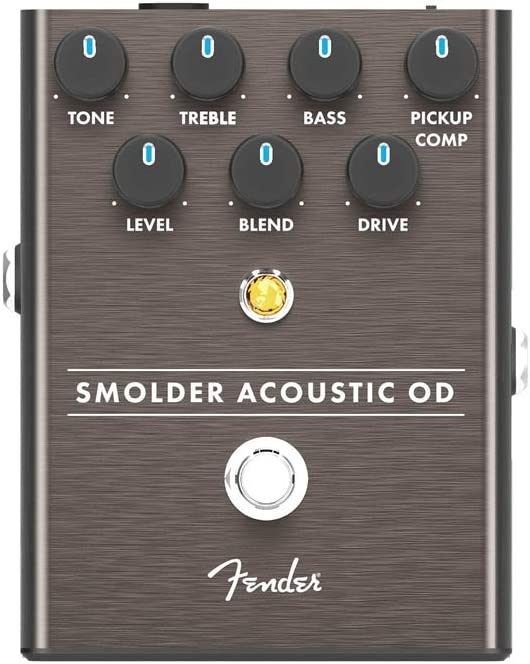
Crafted by Fender, the Smolder Acoustic Overdrive Pedal is a black device designed to inject distortion and overdrive into your acoustic performance.
It’s a compact and lightweight tool perfect for any setup with dimensions of 5.4 by 4.9 by 2.9 inches and only half a kilogram.
What sets the Smolder apart is its analog design, inspired by the authenticity of vintage pedals.
It has a three-band EQ and additional filter controls, allowing you to shape your sound precisely.
Its Pickup Compensation control is particularly impressive; it combines high and low-pass filters that fine-tune the pedal to your pickup type.
This pedal is not just about distortion.
Its full-range voicing makes it ideal for PAs and acoustic amps, offering a depth of sound beyond most pedals.
With easy 9VDC power and sturdy, anodized aluminum construction, it’s well suited for the demands of live performance.
A standout feature is its switchable LED-illuminated controls – practical and visually striking.
- My Review
Oh, the Fender Smolder Acoustic Overdrive Pedal – what an intriguing piece of gear!
You see, it offers an acoustic distortion that’s quite unusual yet undeniably effective.
As soon as I plugged it in, I could tell this wasn’t your run-of-the-mill overdrive pedal.
By adopting a vintage-inspired all-analog design, this device ensures an authentic sound.
Its Pickup Compensation control acts as a wizard, seamlessly optimizing the pedal for different pickup types.
It can even counteract the characteristic brightness of piezo elements, which not all pedals can do.
The pedal hits its stride with the three-band EQ and Filter controls.
They provide an uncanny level of sound-shaping ability.
From deep bass to shimmering treble, every nuance of my playing was enhanced, allowing me to dial in that perfect tone.
A definite highlight was the stage-ready construction.
With its sturdy, anodized aluminum body and switchable LED-illuminated controls, this pedal could endure any gigging scenario.
It seemed ready to perform whenever and wherever, much like a loyal roadie by my side.
However, the Fender Smolder wasn’t without its faults.
That clicky switch, for instance, seemed rather out of place on an acoustic guitar device.
It was so loud that it became a bit distracting during quieter passages of music.
Another quirk was the constant need for tweaking when switching from clean to distorted.
This required some patience and a keen ear for detail.
Despite these small criticisms, the Smolder Acoustic Overdrive Pedal brings a lot.
Its distinctive acoustic overdrive and meticulous sound-shaping controls offer a new world of creative possibilities.
Here are the ratings I’ll give to the Fender Smolder Acoustic Overdrive Pedal:
Yes, it has some quirks, but once you understand them, this pedal can become vital to your acoustic setup.
I’d say it’s a pedal that’s worth trying.
- Pros:
- Great sound for acoustic guitars.
- Versatile tone-shaping controls.
- Effective pickup compensation feature.
- Well-built and durable construction.
- Optimized for full-range devices like PAs.
- Cons:
- Some units may have reliability issues.
- No separate clean output for parallel use.
- Clicky button can be loud and disruptive.
- Switching between clean and distorted tones can be challenging.
- May not deliver heavy distortion for certain preferences.
My final verdict is that the Fender Smolder Acoustic Overdrive Pedal is a versatile, feature-rich pedal with great tone and performance.
With its optimized controls and pickup compensation feature, it caters specifically to acoustic guitars.
The positive reviews highlight its effectiveness in delivering the desired overdriven sound without compromising the acoustic tone.
However, there are a few drawbacks, such as potential reliability issues and the lack of a separate clean output.
Considering its brand reputation and overall value, the Fender Smolder Acoustic Overdrive Pedal receives a positive verdict and is recommended for guitarists seeking to add a touch of overdrive to their acoustic sound.
FLAMMA FS03 Guitar Delay Pedal
FLAMMA FS03 Guitar Delay Pedal: 6 delay effects, 80-second looper, tap tempo, trail-on, and storable presets for inspired sound creation.
The FS03 Digital Delay with Looper Pedal from Flamma features 6 classic delay effects, a Tap Tempo control, preset saving, and a Trail On Function for natural effects fade-out. It also has a looper with 80-second recording capacity and adjustable input level. Its knobs and control allow you to adjust the rate of the dry/wet signal, delay timing, feedback control, and special parameter adjustments.
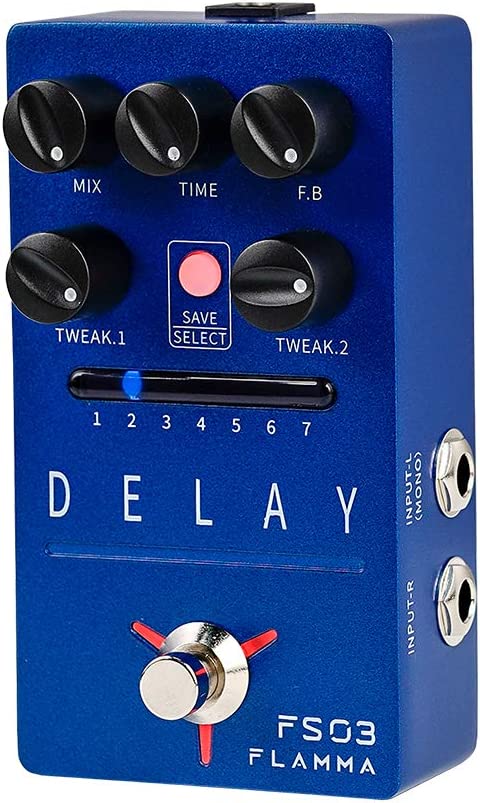
Crafted for guitarists, the FLAMMA FS03 is more than just a delay pedal; it’s a rich sound design tool that brings creative flexibility to your fingertips.
This compact device hosts six unique delay effects, each offering a different color to your sonic palette.
You can excitingly shape and tailor your guitar tone with options like Tape, Liquid, Rainbow, Galaxy, Mod-verse, and Low-bit.
The FS03 doesn’t stop at delay effects.
It also includes a practical looper with an impressive 80-second recording capacity, a feature that allows you to create layered compositions on the fly.
This pedal stands out for its customization options.
You can adjust delay times using the intuitive Tap Tempo function, which bases timing on the gap between footswitch taps.
Moreover, you can save your personalized effects settings for future use.
A special feature, ‘Trail On,’ ensures a natural, gradual fade-out of the effect once the pedal is deactivated.
The FS03 is a powerhouse of functionality, compactly fitted in a casing that weighs only 0.3 kg, sporting an aesthetic ‘Delay Blue’ finish.
- My Review
The FLAMMA FS03 Delay Pedal impresses immediately with its sleek ‘Delay Blue’ aesthetic, compact size, and lightweight.
Handling it, you immediately get a sense of its solid construction, an indicator of its robustness and durability, even for the most energetic performers.
Slipping into my playing session, I felt a sense of artistic freedom thanks to the six different delay effects on offer.
Each one brings a unique flavor, with Tape providing a nostalgic warmth, while Rainbow and Galaxy added an ethereal touch to my compositions.
The Mod-verse and Low-bit effects offered an intriguing edge, transforming familiar riffs into something unexpected.
What looper function stands out for me is the FS03’s, offering a generous 80 seconds of recording time.
It’s a great tool for improvisation and experimentation, letting me weave intricate layers of sound in real-time.
It’s user-friendly, too – even during a passionate solo, I could adjust my input level effortlessly using the TWEAK—One knob.
One of the most thoughtful features is the Tap Tempo function.
It’s a subtle touch, but having the ability to dictate the delay timing with foot taps allowed for an intuitive, organic feel, keeping my hands free to focus on playing.
A notable downside is that the user interface can initially feel overwhelming.
There are a lot of controls to explore, and it may take time for some to get comfortable.
That said, the ability to save presets offsets this, making it easier to capture the perfect sound settings and recall them later.
The Trail On function is a cherry on top – an excellent detail that adds depth and continuity to the sound, allowing the effects to fade out naturally for a smoother transition.
Here are the ratings I’ll give to the FLAMMA FS03 Guitar Delay Pedal:
Despite its minor complexity, the FS03 is a sound investment for any guitarist seeking to enhance their sonic palette.
It truly is a hub of creativity waiting to be explored.
- Pros:
- Versatile selection of 6 delay effects.
- Includes an 80-second capacity looper.
- Storable presets for customized sound.
- Tap tempo function for precise delay control.
- Cons:
- Requires external power supply.
- May have a learning curve for beginners.
My final verdict is that the FLAMMA FS03 Guitar Delay Pedal is a highly versatile and feature-rich option with excellent tone and performance.
The brand has demonstrated a commitment to providing affordable and accessible music technology.
Considering its value for the price, this pedal is a worthwhile investment for guitarists seeking a diverse range of delay effects and a convenient looper function.
MXR Phase 95 Mini Guitar Effects Pedal
MXR Phase 95 Mini Guitar Effects Pedal – Vintage-style phasing in a mini housing.
MXR is a renowned manufacturer of classic guitar effects pedals, from phase shifters and flangers to distortion and overdrives. Offering simple and intuitive controls, MXR pedals are suitable for all styles and levels of guitarists.
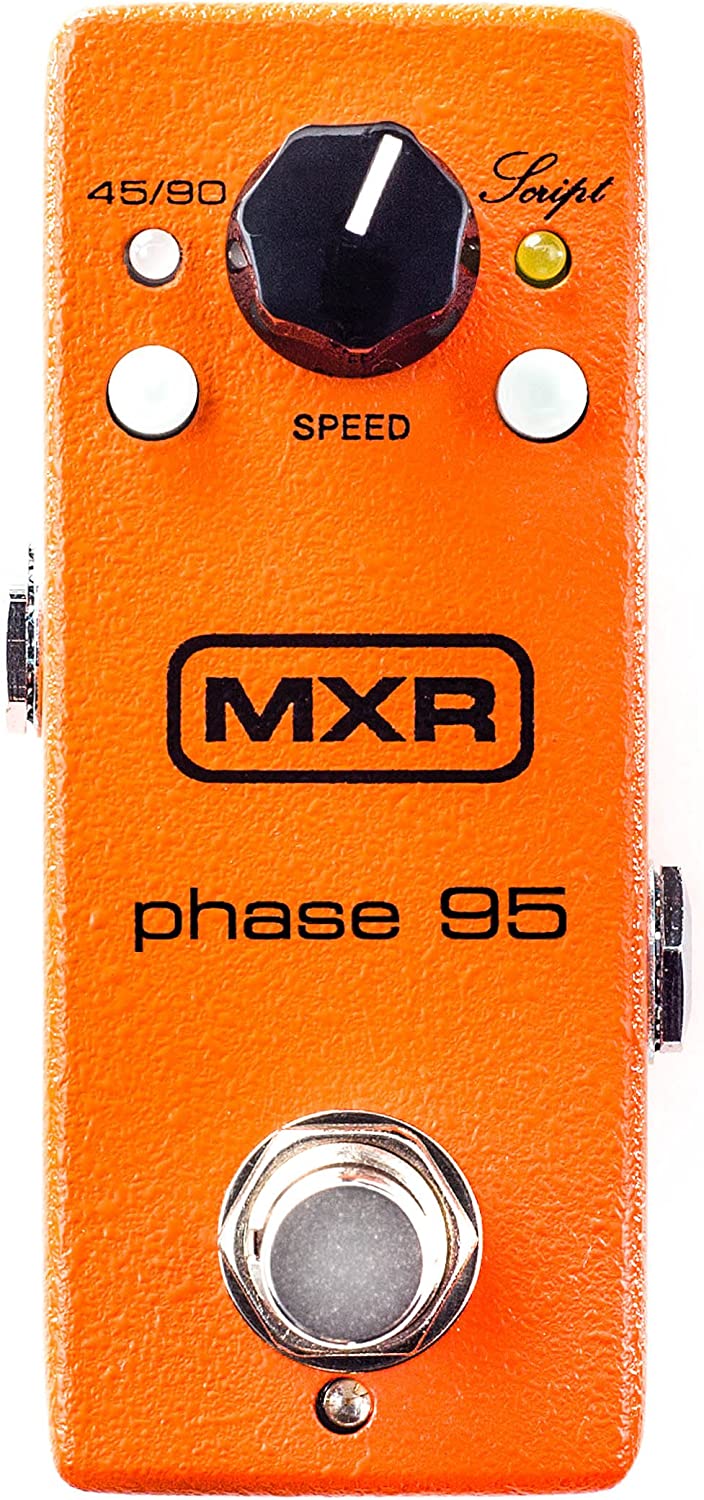
This is a sleek, multi-colored mini guitar effects pedal called the MXR Phase 95 from the renowned JIM DUNLOP brand.
It’s easy to incorporate into your setup, designed with a compact footprint, about half the size of an average MXR pedal.
It cleverly integrates two iconic phase circuits, phase 45 and phase 90, offering a versatile choice of sounds to explore.
You’ll find a 45/90 switch that smoothly toggles between these circuits, each with its distinct sonic flavor.
Another neat feature is the script switch, which lets you move between modern and vintage phasing styles.
Although the package doesn’t include an adapter, this model M290 device does offer a subtler vintage sound by removing feedback when you engage in the script mode.
So, if you’re a superior construction and refined sound fan, this pedal has you covered.
- My Review
Right off the bat, I was genuinely captivated by the MXR Phase 95 Mini Guitar Effects Pedal’s compact design.
Its space-saving size fits right onto a cluttered pedalboard yet packs an impressive punch.
Housed within this compact exterior, I found two distinctive phase circuits, phase 45 and phase 90, offering quite a palette of sounds.
Switching between these two circuits was as simple as a flick of the 45/90 switch.
Phase 45 offered a mellower sound, blending seamlessly into my mix.
Conversely, Phase 90 exhibited a more pronounced phasing, and I could feel the vibrancy.
I appreciated the balance between them, and it provided an ample range for creativity.
I got excited about the script switch. What a unique and valuable addition!
It let me alternate between modern and vintage phasing styles, almost like time-traveling through different sound eras.
The modern style brought a bit of harmonic distortion to the table and created a more pronounced ‘swoosh,’ which was pretty cool.
On the other hand, flipping on the script mode, the sound was more subdued and clearer.
It added richness to my sound, something I’ve not found in many other pedals.
What also stood out to me was its sturdy build.
You can tell it’s a pedal designed to withstand the rigors of gigging.
However, there’s a minor gripe – it didn’t come with an adapter, which was a tad inconvenient.
Also, I noticed some slight tonal coloring when the pedal was active, which wasn’t to my taste.
Still, in my experience with the MXR Phase 95, I’d say it’s a powerhouse in a petite package.
Here are the ratings I’ll give to the MXR Phase 95 Mini Guitar Effects Pedal:
Despite a few hiccups, it stands out with its versatility, quality, and sonic potential.
Whether you’re a newbie or a seasoned musician, it brings something special.
- Pros:
- Compact size and space-saving.
- Combines phase 45 and phase 90 circuits.
- Versatile with different phasing styles and modes.
- High-quality and rich phase tones.
- Good customer support and warranty service.
- Cons:
- Potential volume boost when engaged.
- Subjective difficulty in dialing desired phase.
- Possible residual effect when pedal is off.
- Some reported quality control issues.
- Blinking lights don’t turn off when pedal is off.
My final verdict is that the MXR Phase 95 Mini Guitar Effects Pedal is highly versatile and feature-rich, delivering excellent tone and performance.
Its compact size and ability to combine the phase 45 and phase 90 circuits make it a valuable addition to any pedalboard.
The brand’s reputation for quality and customer support adds to its appeal.
While there have been some reported issues, overall, the pedal offers great value for the price.
Boss CE-2W Waza Craft Chorus Pedal
Legendary BOSS quality for guitarists with 3 modes and rate/depth controls.
BOSS provides reliable and durable guitar gear, easy to use and delivering great results. Renowned for their commitment to tone, innovation and quality, they offer a wide range of products to give guitarists of any skill level the perfect sound.
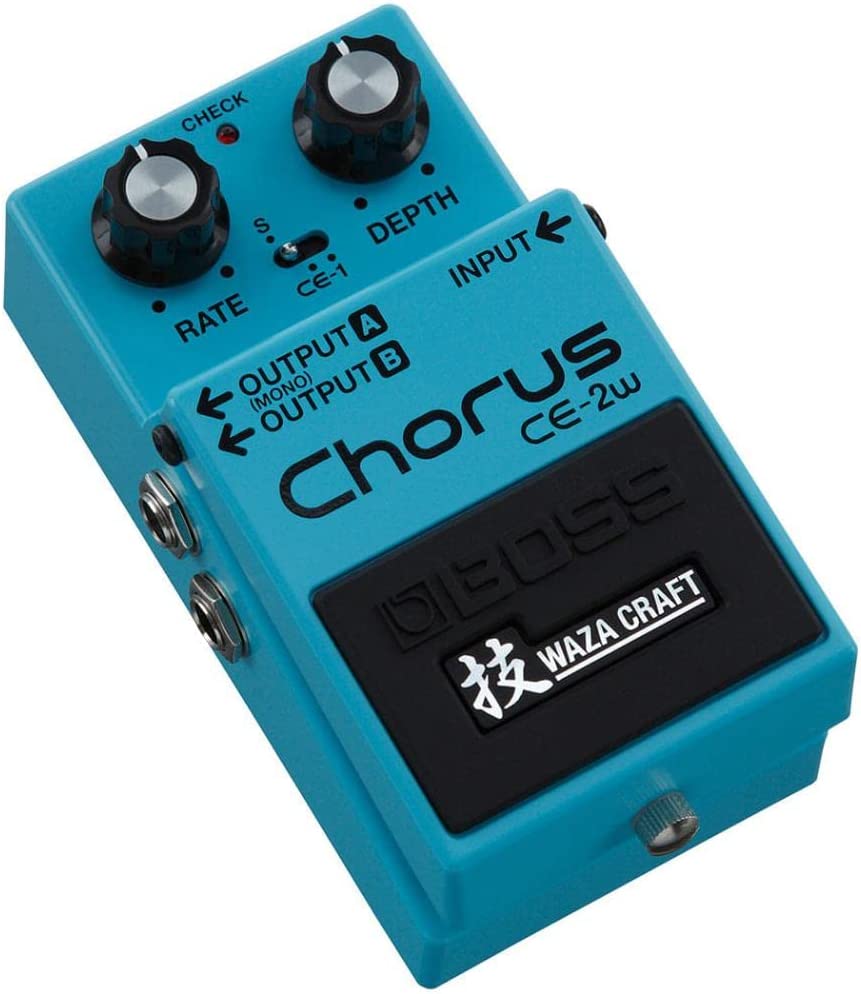
Meet the Boss CE-2W Waza Craft Chorus Pedal – a musical gear innovation that pays homage to the sonic origins of BOSS.
Cast in a striking shade of blue, it hails from Japan, where both its forebears, the original CE-1 and CE-2, were born.
Weighing just 0.46 kilograms, it sports a compact footprint of 6 x 3.8 x 2.65 inches, making it a convenient addition to your setup.
Notably, this effects pedal for guitar boasts three distinct modes – Standard, CE-1 Chorus, and CE-1 Vibrato, allowing for a wide range of sonic exploration.
Both the Rate and Depth controls let you tailor your sound with precision.
Its ‘Standard’ mode mirrors the classic CE-2 chorus sound, now embellished with rich stereo output, adding new depth to your tone.
Furthermore, the CE-1 mode flawlessly replicates the legendary CE-1’s stereo chorus and vibrato sounds, introducing the added benefit of variable chorus depth, a feature not present in the original pedal.
This creation from BOSS, a brand synonymous with quality since 1973, offers a blend of the classic and the modern, perfect for any stage, studio, or home.
- My Review
Stepping into the arena with the Boss CE-2W Waza Craft Chorus Pedal felt like stepping into a piece of music history.
Strumming my guitar with this device in my setup was an authentic journey back to 1976 when the original CE-1 Chorus Pedal debuted.
It’s a compact pedal, lightweight, and beautifully adorned in a stunning blue – aesthetics that certainly caught my eye.
But let’s face it; looks aren’t everything in a pedal.
So, I began to explore its features, where the real magic happened.
As I experimented with the three modes, each bestowed a distinctive and mesmerizing sonic experience.
The Standard mode delivered an immersive stereo output – a definite upgrade from the mono sound of the classic CE-2.
This harked back to the renowned CE-2 chorus sound and introduced a larger sound field.
This expanded stereo spectrum gave a profound depth to my tones, something I’ve been chasing for a while.
Shifting gears to the CE-1 mode, I tasted the vintage CE-1 chorus and vibrato sounds and an unexpected twist.
I had the power to adjust the chorus depth, a luxury the original CE-1 pedal didn’t offer.
This allowed me to fine-tune my sound with surprising accuracy, giving me greater control.
Despite these glowing impressions, I should note that the Rate and Depth controls might require a bit of a learning curve, especially for those new to the effects pedal game.
It might take some time and patience, but once you’ve wrapped your head around these controls, the Boss CE-2W opens a doorway to an impressive and versatile range of sounds.
So, in my experience, this pedal, born from the trusted house of BOSS, embodies both the past and the future.
Here are the ratings I’ll give to the Boss CE-2W Waza Craft Chorus Pedal:
It marries the vintage, sought-after chorus sounds with a modern touch, delivering an enriched sonic experience.
It’s truly a fitting tribute to four decades of BOSS innovation.
- Pros:
- Authentic CE-2 chorus sound.
- Three modes for versatile tones.
- Stereo output for expansive sound field.
- Cons:
- Limited control options.
- Relatively high price point.
- No additional features or effects.
My final verdict is that the Boss CE-2W Waza Craft Chorus Pedal is a high-quality chorus pedal with authentic CE-2 chorus sound and versatile tone options.
Its performance is excellent, and the brand, BOSS, is well-known and trusted among guitarists.
However, it may lack some advanced features and controls, and some buyers’ price point might be relatively high.
Overall, it offers a great tone and performance, making it a solid choice for those seeking a classic chorus sound.
L.R. Baggs Venue DI Acoustic Guitar Preamp Pedal
Studio-quality sound for the stage with LR Baggs Venue DI.
The Venue DI is an all-in-one acoustic pedal, featuring a full isolation DI output, 5-band EQ, variable clean boost and chromatic tuner. It delivers studio-quality sound with its all discrete signal path and audiophile-grade components.
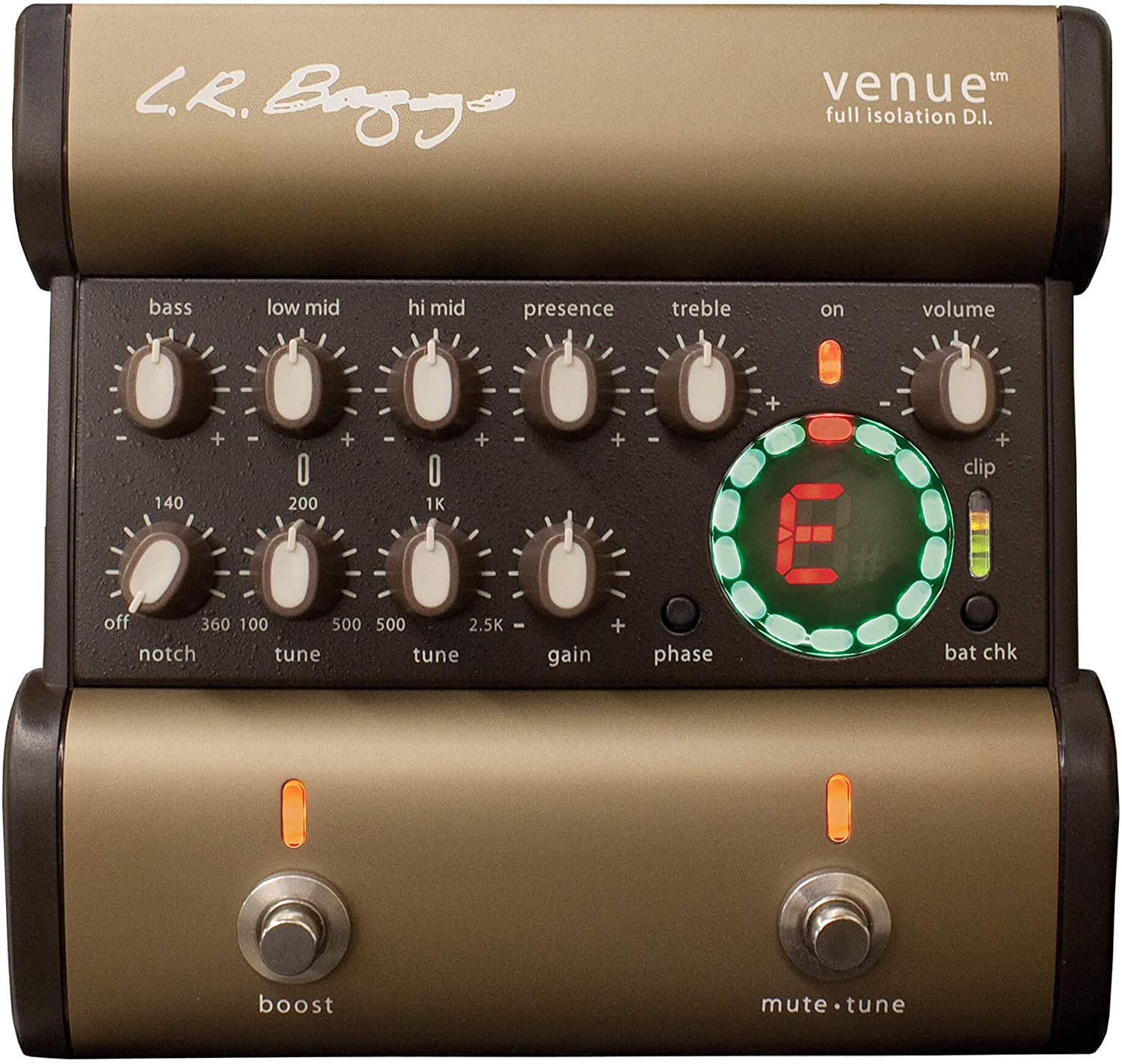
Crafted to ensure you perform your best wherever you plug in, the L.R. Baggs Venue DI Acoustic Guitar Preamp Pedal is your one-stop acoustic solution.
This compact, brown device packs a potent punch with its adjustable gain that caters to passive and active pickups.
A standout feature is its five-band EQ, which includes tunable low-mid and high-mid bands, allowing you to shape your sound precisely.
One of its unique offerings is the Garret Null notch filter, adept at curbing feedback, ensuring a cleaner performance.
Another innovative touch is the fully chromatic tuner, paired with a footswitch mute/tune function, making tuning effortless.
The pedal also features an adjustable volume boost footswitch for those soaring solos.
It’s not just practical; it’s designed to give you a studio-quality sound right on stage, a testament to its high-grade semiconductors and exclusive use of audiophile-grade film capacitors.
- My Review
Let’s begin with the design – compact and stylish, the brown finish gives it a classic, almost vintage appeal.
At three pounds, it’s relatively lightweight, making it easily portable and convenient for those on the move.
Now, the quality of sound that it delivers is quite impressive.
It’s the kind of sound that feels crisp, clean, and true to the essence of an acoustic guitar.
Having the adjustable gain to cater to both passive and active pickups is beneficial, as it provides versatility and customization to suit different styles and preferences.
One feature that stands out is the five-band EQ with adjustable low-mid and high-mid bands.
Being able to fine-tune your sound in this way gives you more control and lets you shape your tone more precisely.
Moreover, the Garret Null notch filter is fantastic for reining in unruly feedback – an essential feature when performing live.
However, as much as I appreciate the fully chromatic tuner, it does have its drawbacks.
It could be more responsive, as it sometimes feels a bit sluggish and needs occasional prodding to wake up from its sleep mode.
And while the footswitch mute/tune function is handy, the tuner could be improved.
The high-grade semiconductors and audiophile-grade film capacitors are noteworthy in terms of construction and materials.
Quality components have been used to ensure superior audio performance.
Finally, the adjustable volume boost footswitch is a nice touch for ramping up your solos.
Here are the ratings I’ll give to the L.R. Baggs Venue DI Acoustic Guitar Preamp Pedal:
While it has some room for improvement, the L.R. Baggs Venue DI does a commendable job of combining many useful features into one compact package.
This device is not just practical – it’s a solid investment in your sound.
- Pros:
- Adjustable gain for passive and active pickups.
- 5-band EQ with tunable low-mid and high-mid bands.
- Effective feedback control with Garret Null notch filter.
- Full chromatic tuner with footswitch mute/tune function.
- Adjustable volume boost footswitch.
- Cons:
- Tuner can be sluggish and unreliable for some users.
- Some users experience issues with the tuner shutting off.
- Price may be considered high for some customers.
My final verdict is that the L.R. Baggs Venue DI Acoustic Guitar Preamp and DI is a versatile, feature-rich device with excellent tone and performance.
The brand is well-regarded in the industry, and while the product offers great value for its features, the price may be a consideration for some customers.
Overall, it is a highly recommended option for musicians seeking studio-quality sound and control over their acoustic instrument tones.
ISET Looper Pro Guitar Loop Effect Pedal
ISET’s quality audio products for musicians at affordable prices.
ISET Audio offers a range of small, easily powered effects pedals with true bypass design, making them great for live performances or building out a pedal board. Their products are designed and produced with quality control and passion for music, making them a great choice for musicians.
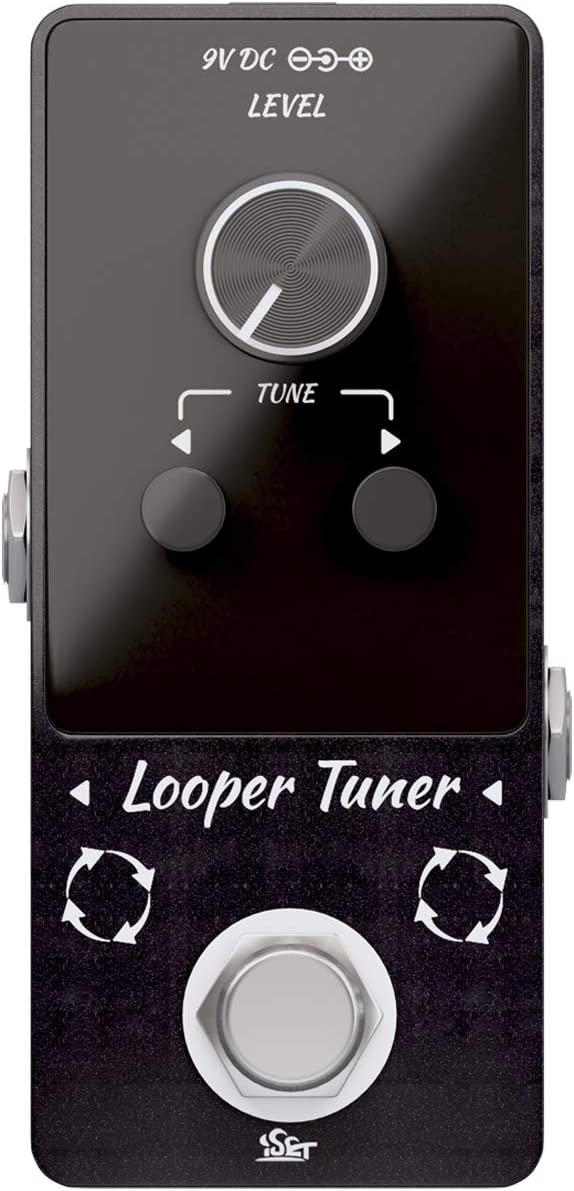
A little powerhouse in music, the ISET LOOPER PRO Guitar Loop Effect Pedal is a musician’s dream.
This clear, compact device, with dimensions of 3.54 x 1.57 x 1.57 inches, is specifically designed for ease of transport and great sound.
With nine loops and a generous 40 minutes of recording time, you can explore unlimited overdubs.
It’s also designed with a handy built-in tuner and LED display.
Powering up is straightforward, allowing the use of an adapter with daisy chain cables or a pedal power supply.
Just ensure you have a 9V power source with a center negative.
True bypass design and small size make it a breeze to fit on your pedal board and adjust pedal positions as required.
Produced by ISET Audio, a company driven by its love for music and commitment to high-quality, affordable musical equipment, this pedal is part of a growing range of instruments and equipment from the brand.
It’s a testament to their focus on delivering exceptional music gear developed with passion, precision, and expertise.
- My Review
First off, you can’t help but appreciate the portability of the ISET LOOPER PRO Guitar Loop Effect Pedal.
Its small footprint makes it a breeze to slip into your gig bag or stow away in your luggage.
Despite its size, the capacity for creativity it offers is immense.
I loved the fact that it provides a total of nine loops, each capturing up to 40 minutes of music.
For an artist, this means a vast canvas to sketch musical ideas, layer sounds, and compose intricate arrangements.
One thing that impressed me was the built-in tuner.
It’s such a convenient feature, saving space on the pedal board and simplifying the setup.
The LED display complements this beautifully, keeping you informed and in control.
And speaking of control, the power requirements are easily manageable.
A standard 9V power source does the trick, meaning it fits seamlessly into most pedal power setups.
Let’s talk sound. This pedal delivers.
The audio integrity remains strong throughout, with no noticeable degradation after multiple overdubs.
I had an absolute blast creating dense, intricate sonic landscapes with this little device.
However, I should mention that there might be a learning curve for absolute beginners to looping, as it does require a certain sense of timing and structure.
But that’s part of the fun, right?
What stands out is ISET’s passion for creating great musical gear, and it’s evident in the LOOPER PRO.
It’s not just another pedal; it’s a platform for musical exploration.
They’ve struck a great balance between quality, price, and functionality.
Here are the ratings I’ll give to the ISET Looper Pro Guitar Loop Effect Pedal:
Sure, there might be more advanced loopers out there, but the ISET LOOPER PRO holds its own for its size and price point.
It’s a must-have for any creative musician looking to add looping to their toolbox.
- Pros:
- Compact size for easy portability.
- 9 loops with 40 minutes recording time.
- Built-in tuner for convenience.
- Cons:
- May have a learning curve for beginners.
- LED display could be small and hard to read.
My final verdict is that the ISET LOOPER PRO Guitar Loop Effect Pedal is a highly versatile and feature-rich product with excellent tone and performance.
The brand, ISET Audio, demonstrates a commitment to quality and affordability.
Considering its compact size, nine loops with 40 minutes of recording time, built-in tuner, and overall positive features, this pedal offers great value to musicians.
While it may have a slight learning curve for beginners, and the LED display could be small, the pros outweigh these cons.
Overall, I recommend the ISET LOOPER PRO Guitar Loop Effect Pedal to guitarists looking for a reliable and convenient looping solution.
Zoom A1 FOUR Acoustic Instrument Multi-Effects Pedal
Zoom A1 FOUR provides tailored effects for acoustic instruments with looper, rhythm section, and Guitar Lab support.
The A1FOUR is a multi-effects processor designed for acoustic instruments, offering over 80 preloaded effects and a built-in looper and drum machine. It provides acoustic guitar players with warm and rich tones, and sax, trumpet, and violin players with a vast soundscape of possibilities. It also features EQ, compressor, and Guitar Lab support.
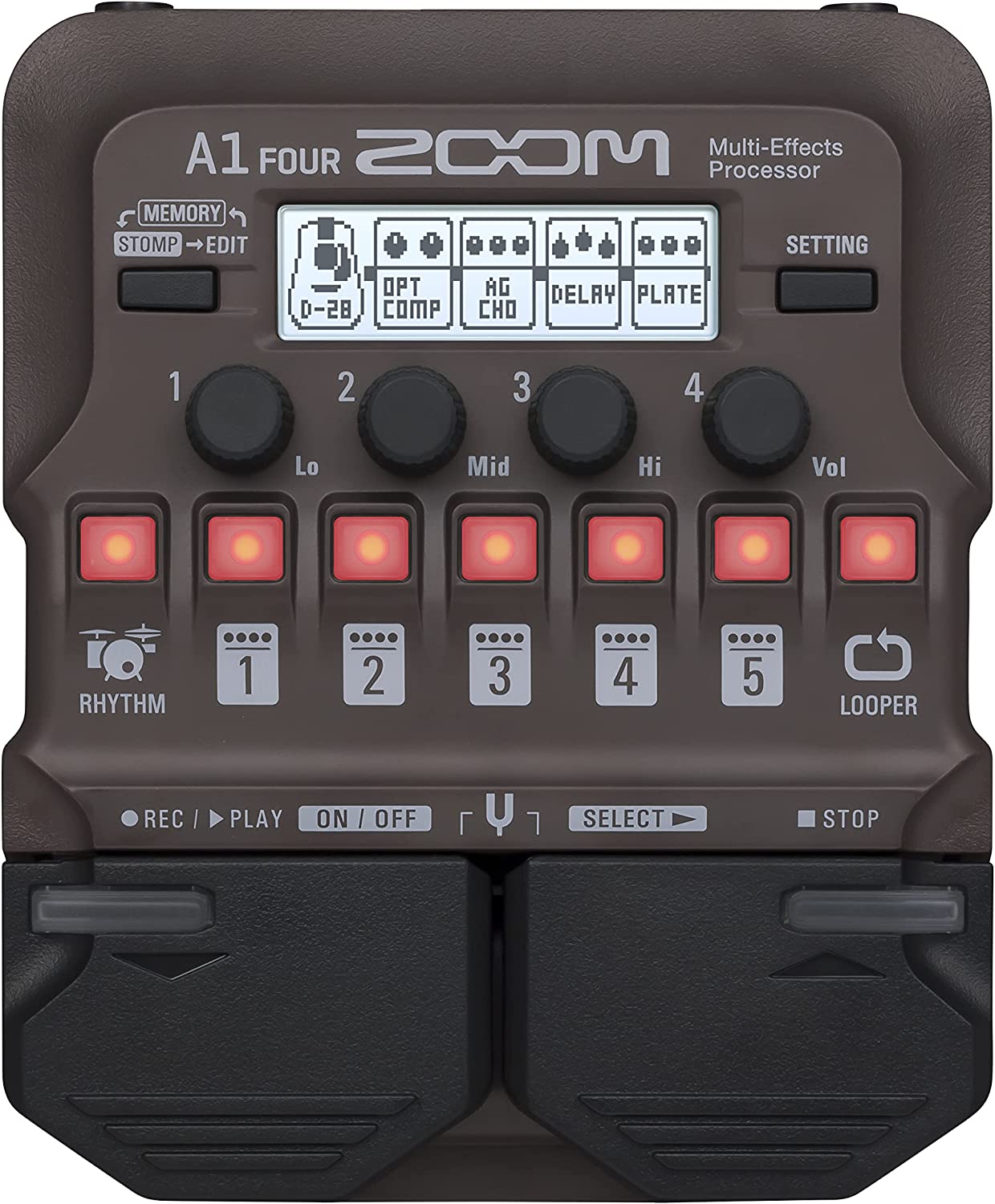
The Zoom A1 FOUR Acoustic Instrument Multi-Effects Processor Pedal is an innovative device designed to enhance the sound of various acoustic string and wind instruments.
This versatile pedal has over 80 effects, including more than 35 new ones specifically engineered for acoustic instruments.
This processor pedal offers acoustic guitar players a wide range of warm and rich tones, with acoustic emulators and modeling that can bring a live performance closer to its studio recording counterpart.
Saxophonists can also benefit from this pedal, with features like SaxChorus creating a natural, doubled sound.
For those who play the trumpet, violin, harmonica, or upright bass, the A1 FOUR has various unique effects to cater to any genre or style.
The built-in looper and drum machine makes it the perfect accompaniment tool with 68 rhythm patterns tailored for acoustic music.
The device is compatible with Zoom’s Guitar Lab software, allowing users to explore various patches and effects.
The Zoom A1 FOUR operates on 4 AA batteries, providing up to 18 hours of use, while the MAA-1 mic adapter requires 2 AA batteries.
- My Review
Having tried out the Zoom A1 FOUR Acoustic Instrument Multi-Effects Processor Pedal, I found it to be quite an impressive piece of equipment.
It offers many features and caters to many different instruments, making it a valuable addition to any musician’s toolkit.
First and foremost, the sheer number of effects available and their quality blew me away.
With over 80 effects to choose from, there’s no shortage of possibilities for crafting unique sounds and textures.
One aspect that stood out was the acoustic emulators and modeling features; they did an excellent job of replicating the natural sound of different guitar bodies and felt truly authentic.
I also appreciated the built-in looper and drum machine, which provided great options for practicing and trying out new ideas.
The 68 rhythm patterns, tailored specifically for acoustic music, offer a lot of creative inspiration and help take your playing to new heights.
The compatibility with Zoom’s Guitar Lab software is another bonus of the A1 FOUR, as it provides even more ways to experiment with patches and effects.
It’s a great way to curate your sound and find the perfect combinations for your performances.
One drawback I noticed was that the device is powered by 4 AA batteries, which means that battery life could be an issue in the long term.
However, the A1 FOUR boasts a respectable 18 hours of battery life, so it shouldn’t be a major problem as long as you remember to keep some spare batteries on hand, it shouldn’t be a major problem.
Here are the ratings I’ll give to the Zoom A1 FOUR Acoustic Instrument Multi-Effects Pedal:
In my experience, the Zoom A1 FOUR Acoustic Instrument Multi-Effects Processor Pedal exceeded expectations regarding its versatility and potential for enhancing the sound of various acoustic instruments.
While it’s not immune to minor issues like battery life, it remains an invaluable addition to any musician’s gear.
- Pros:
- Over 80 high-quality effects.
- Acoustic emulators and modeling.
- Built-in looper and drum machine.
- Cons:
- Requires 4 AA batteries.
- Long-term battery life concerns.
- No major cons detected.
My final verdict is that the Zoom A1 FOUR Acoustic Instrument Multi-Effects Processor Pedal is a highly versatile and valuable addition to any musician’s gear, offering an extensive range of effects, outstanding acoustic emulation, and a built-in looper and drum machine.
Despite some minor concerns with battery life, its features, performance, and overall value make it a must-have for those seeking to enhance their acoustic instrument’s sound.
Boss ME-80 Multi-Effects Pedal
Huge selection of BOSS effects, hands-on knobs, and intuitive footswitches for ultimate control.
The ME-80 provides a user-friendly interface with dedicated knobs for instant access to a huge selection of BOSS effects. It also offers both stompbox-style control and instant recall of complex multi-effects setups, plus unique footswitches for efficient and intuitive effects switching. Its free software adds even more tonal possibilities.
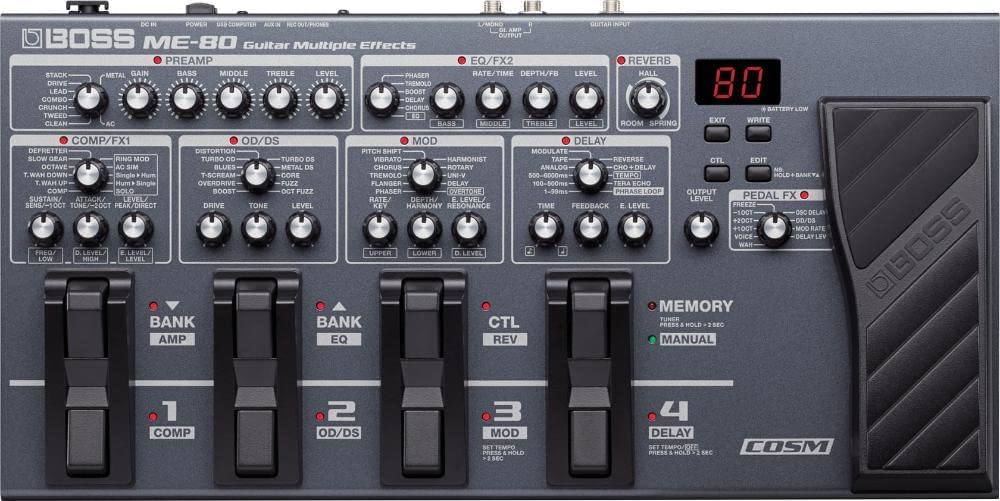
The Boss ME-80 Multi-Effects Pedal is a versatile and compact solution for guitarists who seek a wide range of high-quality effects.
It is powered by batteries, making it easy to carry around and set up.
The user-friendly knob-based interface lets you quickly dial in your desired tone, with individual effect categories that can be active simultaneously.
This pedal has various Boss effects, including overdrives, distortions, wahs, modulations, pitch shifters, and delays.
The innovative Multi-Dimensional Processing (MDP) technology provides unique soundscapes like Tera Echo, and Overtone and updated COSM preamps for various styles such as Crunch, Metal, and AC for acoustic-electric guitars.
The onboard expression pedal offers control over volume and additional effects like wah, octave shift, and Freeze.
The ME-80 allows stompbox-style on/off adjustments and instant recall of complex multi-effects setups.
With 36 user patch locations, saving and recalling your custom effects configurations is easy.
The newly developed footswitches offer efficient and intuitive control for effects switching, patch selection, and real-time sound shaping.
- My Review
In my experience using the Boss ME-80 Multi-Effects Pedal, I found it incredibly versatile and user-friendly gear, perfect for guitarists looking to explore a myriad of tones and effects.
Thanks to the battery-powered design, its portability made it incredibly convenient to carry to gigs or rehearsals.
One of my standout features was the knob-based interface, which made dialing in my desired sound a breeze, with no need for scrolling through endless menus.
The ability to use multiple effects categories simultaneously opened up a wide range of creative possibilities.
I was particularly impressed with Boss’s Multi-Dimensional Processing (MDP) technology, which offers unique and immersive sonic textures like Tera Echo and Overtone.
The onboard expression pedal added another layer of interactivity to my playing, allowing for live adjustment of volume and effects like wah, octave shift, and Freeze.
I appreciated the option to choose between stompbox-style on/off adjustments and recalling complex multi-effects setups, catering to performance and creative situations.
However, my only minor criticism is that the compact footswitch design may take some time to get used to, especially if you have larger feet or are used to traditionally isolated footswitches.
But once the learning curve is overcome, you’ll appreciate the efficient and intuitive control these footswitches provide.
Despite the initially challenging footswitch design, the Boss ME-80 Multi-Effects Pedal truly offers an extensive range of effects and tonal possibilities, coupled with a user-friendly interface.
Here are the ratings I’ll give to the Boss ME-80 Multi-Effects Pedal:
I enjoyed the balance between ease of use, versatile sound-shaping options, and performance-friendly features that truly elevate the guitar’s experience.
It’s a powerful, compact, and portable multi-effects solution that every guitarist should try.
- Pros:
- User-friendly knob-based interface.
- Wide range of high-quality effects.
- Portable and battery-powered.
- Cons:
- Compact footswitches require practice.
- Limited to 36 user patch locations.
My final verdict is that the Boss ME-80 Multi-Effects Pedal is an outstanding choice for guitarists seeking a wide array of high-quality effects in a portable and user-friendly package.
Its versatility, impressive features, excellent tone, top-notch performance, and great value make it a must-have pedal for any serious guitarist.
What exactly is an acoustic guitar pedal?
An acoustic guitar pedal is a device that enables guitarists to modify or enhance the sound of their acoustic guitar.
It is a compact electronic gadget, typically designed to be used with an acoustic-electric guitar or a microphone.
These pedals enable guitarists to customize the tone, resonance, and various other aspects of their instrument while maintaining the natural and organic sound of the acoustic guitar.
The term “pedal” comes from the fact that these devices are often controlled by foot switches, allowing the guitarist to smoothly toggle different effects on and off without interrupting their performance.

Acoustic guitar pedals come in various shapes and sizes and can be grouped into various categories according to their functionality.
One of the most common acoustic guitar pedals is the preamp pedal, a signal processor.
These pedals are designed to amplify the weak electrical signal produced by the guitar’s pickup and prepare it for recording or amplification.
They often include built-in EQ (equalization) controls, which enable the guitarist to adjust their sound’s bass, midrange, and treble frequencies.
Additionally, some preamp pedals have built-in compression and limiting features, which help control the sound dynamics and ensure the final output is even.
These features help produce a more balanced and polished sound that can withstand the demands of live performance or studio recording.
Reverb and delay effects are crucial for acoustic guitarists looking to add depth and ambiance to their sound.
Reverb is the effect created by countless tiny echoes that build upon each other, simulating the sound of playing in a large or reflective room.
On the other hand, Delay consists of distinct echoes of the original sound played back at varying intervals.
Acoustic guitarists can use reverb to create the impression of playing in various environments, such as concert halls, cathedrals, or intimate clubs.
Delay can add texture to lead lines, create an extra layer of rhythm, or produce psychedelic sonic landscapes.
While some reverb and delay effects are built into amplifiers or mixers, having a dedicated pedal allows for greater control over these effects.
Using a pedal, the guitarist can easily switch between different reverb or delay settings during a performance.
Some pedals also offer combination reverb/delay effects, allowing players to blend the two effects simultaneously.
Chorus, phaser, and flanger pedals are used to create unique, evolving, and spatial textures that can add an element of sophistication to an acoustic guitar’s sound.
These modulation effects work by duplicating the guitar’s signal, altering it, and then blending it back with the original to create an interesting movement and interaction between the two signals.
A chorus pedal works by slightly delaying and detuning the duplicate signal.
This creates a rich and shimmering effect similar to the sound of a choir or double-tracking in a recording studio.
Phaser pedals create a swishing, sweeping sound by shifting the phase of the duplicate signal.
Flanger pedals, on the other hand, mix the duplicate signal with the original while varying the time delay, resulting in a distinctive swooshing or jet-like effect.
Despite their associations with electric guitars, these modulation effects can also be used with acoustic guitars.
They can add color and dimension to the sound, especially when used sparingly and at low intensity.
Looper pedals allow musicians to record a short passage of their playing and repeat it continuously.
This can be a powerful tool for creating lush soundscapes or rhythmic backing for a solo performance.
Some loopers also allow multiple loops to be stacked, giving the impression of multiple musicians playing together.
Multi-effects pedals are a versatile solution for guitarists looking to incorporate several different effects into their setup without needing multiple individual pedals.
These all-in-one units offer various preamp, EQ, modulation, and time-based effects that can be customized and organized to the player’s preference.
What should you consider when choosing an acoustic guitar pedal:
When choosing an acoustic guitar pedal, there are a plethora of factors that you must consider to ensure that you get not only the right pedal for your needs but also a high-quality product that is worth the money invested.
Let’s dive deeply into these factors and explore their significance:
– Sound quality

One of the primary things to consider when choosing an acoustic guitar pedal is its sound quality.
You want a pedal that can produce rich, musical, and clear tones that will accurately reproduce the natural acoustic qualities of your guitar.
The right pedal should not only emphasize the unique characteristics of your guitar but also provide the desired effects without any unwanted noise or distortion.
When assessing sound quality, it is crucial to research how the pedal processes the guitar’s signal.
Start by understanding whether the pedal has a true or buffered bypass configuration.
A true bypass pedal will not affect your guitar’s signal when.
In contrast, a buffered bypass pedal can discreetly ‘strengthen’ your guitar’s signal and help maintain a consistent tone throughout your effects chain.
The type of components used within the pedal will also contribute to the sound quality.
While some pedals can be equipped with budget-friendly components, others will feature higher-end components known for their low noise floor, which allows for better dynamic range and sonic clarity.
– Controls and features

Another key aspect to consider when choosing an acoustic guitar pedal is the controls and features it offers.
You want a pedal that is intuitive, easy to use, and offers the flexibility to shape your sound to perfection.
Ensure the control layout matches your playing style to find the best fit.
Different pedals will have distinct controls, such as knobs, sliders, or buttons, which may be more comfortable or convenient for you to operate.
Some pedals will have minimal controls to maintain a user-friendly design, while others will have many features to meet the demands of experienced players.
Additionally, consider including onboard effects such as reverb, chorus, or delay, which can dramatically enhance your guitar’s natural acoustic tones.
These effects allow you to explore new sonic landscapes and create a more immersive, lush acoustic environment.
– Analog vs. digital

The decision between an analog or digital acoustic guitar pedal boils down to personal preference and the desired characteristics you want to capture in your sound.
Analog pedals are known for their warm, natural, and sometimes slightly unpredictable tones, which can provide an organic and vintage feel to your sound.
Digital pedals, on the other hand, are celebrated for their precise, clean, and consistent sound reproduction.
Analog pedals alter your guitar’s signal through electronic components, such as transistors, capacitors, and resistors.
These components may be more susceptible to environmental factors, such as temperature and humidity, which could impact the performance or longevity of the pedal.
Furthermore, analog technology is inherently limited due to the finite ability of these components to process an input signal.

Digital pedals utilize digital signal processing (DSP) chips to convert your guitar’s analog signal into a digital format.
This digital format allows for more complex sound manipulations, high-quality signal processing, and the ability to work with multiple effects simultaneously.
The benefits and drawbacks of analog and digital pedals should be carefully weighed to determine which type best suits your needs.
Ultimately, it is important to remember that having a combination of both analog and digital pedals in your arsenal could expand your tonal possibilities and complement various situations or playing styles.
– Build quality and durability

Considering an acoustic guitar pedal can be a pricey investment, it is critical to examine a pedal’s build quality, craftsmanship, and durability before making your purchase.
A well-built pedal should resist the wear and tear of being stepped on, unplugged, and transported regularly.
Start by evaluating the materials used for constructing the pedal’s chassis, which should be made from a robust and durable metal or hard plastic that can withstand consistent use.
Furthermore, pay attention to the quality of the input and output jacks and switches, and potentiometers (knobs).
These parts should be sturdy and securely fastened to the pedal’s chassis to prevent unnecessary wobbling or looseness.
Another durability aspect is the pedal’s power supply, which should be compatible with common power requirements and offer reliable performance.
Ideally, the pedal should have a dedicated power supply or work seamlessly with multi-pedal power supplies to integrate easily into any pedalboard.
– Presets and versatility

In selecting an acoustic guitar pedal, it is wise to consider the range of presets and versatile sound-molding options available.
Presets are pre-configured settings that offer specific sound profiles, such as room, hall, or plate reverb settings.
Presets give you instant access to tried-and-tested sonic configurations and the freedom to modify or create custom settings.
Versatility in a pedal also involves its capability to handle different types of guitars, musical genres, and playing techniques.
A pedal that caters to various playing styles, from fingerpicking to strumming, and that can adapt to different types of acoustic guitars, such as dreadnought, classical, or parlor guitars, will provide an even more practical and adaptable option for your sound needs.
– Brand reputation

As with any product, brand reputation is a significant factor when selecting an acoustic guitar pedal.
Trusted and reputable brands in the music industry have built their reputations through years of research, innovation, and commitment to customer satisfaction.
Reputable brands are more likely to offer high-quality products thoroughly tested and engineered for excellent sound and performance.
Furthermore, these brands typically have superior customer support and offer warranties to back up their products.

A good rule of thumb is researching the brand’s history, product range, and overall standing in the music industry.
Testimonials and reviews from musicians who have used products from these brands can help get an idea of the brand’s reputation.
– Price and budget

One of the essential factors to bear in mind while selecting an acoustic guitar pedal is your budget.
Guitar pedals span a wide price range, from inexpensive entry-level models to premium high-end options.
When determining your budget, weigh the importance of specific features, sound quality, and build quality with the amount you are willing to spend.
Buying an inexpensive pedal that sacrifices essential features or sound quality may leave you unsatisfied while purchasing a high-end pedal with an array of features you may never use can be inefficient.
It’s worth shopping around, comparing different models, and potentially waiting for sales or deals to maximize the value of your investment.
– Reviews and recommendations

Last but not least, reviews and recommendations can be a goldmine of information and insight when deciding to choose an acoustic guitar pedal.
Reviews from reputable online sources, such as music blogs, gear forums, or YouTube gear reviews, can provide valuable information on different pedals’ performance, build, and sound quality.
It is also worth talking to friends or fellow musicians who may have experiences or recommendations for specific pedals.
Local music stores and guitar shops can provide opportunities for hands-on testing of various products, which can be a deciding factor in finding the perfect pedal.
How to properly use an acoustic guitar pedal?
Okay, so you’ve bought a few pedals that you’ll use on your acoustic guitar, what now?
In this section, I’ll go over some tips to get the best out of these pedals, and sound as good as possible.
– Familiarize yourself with the controls and features:
Becoming acquainted with all its controls and features is crucial to use an acoustic guitar pedal proficiently.
This will take some time as you carefully read the owner’s manual, identify each component on the pedal, and gain an understanding of the various functions and settings.
Study the layout and get comfortable finding and adjusting the knobs, switches, and buttons responsible for different effects.
Take note of input and output jacks and external control options, such as MIDI or expression pedals.
Look into your pedal’s specific effects, including modulation, delay, reverb, EQ, and compression.
Understand how these effects impact your sound and learn the optimal settings for each depending on your needs and preferences.
Familiarizing yourself with each control and feature will put you in a better position to tailor your pedal to your distinct musical goals and quickly alter your sound as needed during live performances or recording sessions.
– Adjust the parameters to suit your musical goals:
Once you understand the pedal’s capabilities, spend time adjusting its parameters so they align with your musical goals
Manipulate each setting to create different effects and tones, experimenting with combinations to enhance your sound.
Adjust the modulation effect’s intensity, speed, or resonant frequency to create a mild chorus or an intense flanger, depending on your needs.
Tweak delay settings to create short, repeating notes or choose longer settings that slow the repetitions for a more ambient sound.
Change the reverb parameters to add depth and space to your guitar tone by emulating the sound of a small room or a large hall.
Remember that personal taste and style will play a large role in determining the best settings for your acoustic guitar pedal.
Experimenting with various parameter adjustments will help you find the perfect balance and create the specific sound you want to achieve with your guitar.
– Incorporate the acoustic guitar pedal into your signal chain:
Incorporating your acoustic guitar pedal into your signal chain involves connecting your instrument, the pedal, and your amplifier using quality instrument cables to ensure minimal signal loss and degradation.
Consider your pedal’s position in the signal chain, as this will significantly impact your tone and howpedal’sdal interacts with other effects units, such as overdrives, compressors, or modulations pedals.
A popular arrangement is to place your acoustic guitar pedal after compression, overdrive, and before time-based effects, such as delay and reverb.
This placement will help preserve the natural quality of the guitar while allowing the pedal to enhance or shape the tone before passing through to other effects.
Determine the ideal configuration by experimenting with different combinations, as optimal placement can vary depending on personal preference, the type of guitar pedal, and the overall effects setup.
– Test the pedal’s functionality and performance:
After you have connected the pedal to your guitar and amplifier, it’s crucial to test its performance by playing your instrument and cycling through various settings and effects.
Familiarize yourself with how the pedal responds to parameter changes, and make sure all controls work correctly.
Verify that each setting sounds as expected and note any issues, such as volume drops or undesirable noise.
Fine-tuning your settings in response to any problems or imbalances will help you utilize your pedal to its full potential and create the optimal sound for your guitar.
As you test your pedal, pay close attention to the unique character that each effect brings to your sound.
Listen to the nuances, richness, and clarity in the various tones produced by the pedal.
Play through different styles and techniques, such as fingerpicking, strumming, and soloing, to ensure the pedal works well in various contexts.
As you assess the pedal’s functionality, note how it interacts with your guitar’s natural sound and tone.
Some pedals may over-color a guitar’s tone, while others may maintain or even enhance its natural character.
Determine whether the pedal adds value to your acoustic guitar sound and adjust accordingly.
In addition, explore the reaction of your guitar’s pickup system and amplifier to the various effects.
Test if the pedal imparts any unwanted noise or feedback when manipulated, and evaluate how effectively it maintains the signal strength throughout the entire range of effects and settings.
If you experience compatibility issues, consider upgrading to a better pickup system or investing in a suitable preamp or DI box for acoustic guitars.
Beyond testing the functionality and performance of your acoustic guitar pedal, it’s also essential to consider its practicality and ease of use on stage or during recording sessions.
Can you comfortably and safely access all the controls and switches on the pedal live?
Does the pedal’s size and shape fit well within your existing pedalboard setup?
Consider adjusting your equipment arrangement to maximize efficiency and ergonomic compatibility if necessary.
As you continue to familiarize yourself with the pedal’s functionality, performance, and practicality, you may also want to consult other musicians, guitar techs, or online communities for further insights and advice on optimizing your acoustic guitar pedal usage.
By thoroughly testing the pedal’s functionality and performance, you can ensure that it reliably elevates your acoustic guitar sound in any situation, whether live performances or recording sessions.
Taking the time to resolve any issues and achieve a harmonious relationship between your pedal, guitar, and amplifier will result in a more satisfying and enhanced musical experience.
– Develop a unique tone according to your playing style:
To develop a unique tone that sets you apart from other musicians, start by carefully listening to and analyzing your favorite guitarists and understanding the key elements of their tone that appeal to you.
This exercise will inspire you and provide a foundation for creating your sound.
As you experiment with various settings and effects, consider how combinations impact various aspects of your tone, like dynamic range, clarity, sustain, and richness.
Note the characteristics that resonate most with your playing style and consider how they may foster your signature sound.
When working with the effects provided by your acoustic guitar pedal, think in terms of layers or dimensions.
Try building your tone using subtle enhancements rather than immediately focusing on extreme settings.
Gradually combine and adjust the settings to add depth, color, or texture to your guitar sound.
Remember that creating a unique tone doesn’t always equate to using radical effect settings; sometimes, a more refined and subtle approach can yield intriguing and memorable results.
Additionally, consider the specific genres of music you play and their associated guitar tones, as these will inform your choice of effects and settings.
For example, fingerstyle guitarists often benefit from subtle reverb and compression to add warmth and depth to their sound.
In contrast, rock guitarists may use more aggressive modulation and overdrive effects to bolster their performances.
When developing your unique tone, consider the performance space and environment where you’ll play.
Different venues and recording situations may require variable effects settings to maintain a consistent sound.
Learn to adapt your pedal settings for different situations, whether playing in small clubs or large concert halls or recording in a professional studio.
While working with acoustic guitar pedals, don’t neglect your personal technique and guitar choice, as both contribute significantly to your overall tone.
Enhance your fingerpicking or strumming technique, develop a distinct approach to using a pick or controlled vibrato, and consider how the choice of a particular guitar, strings, and pick contributes to your sound.
Another important aspect of developing your unique tone is incorporating your artistic and emotional expression as a musician.
Although effects pedals are essential for shaping your sound, remember that your personality and musical message should shine through any given effect.
This balance will ultimately ensure your sonic identity remains authentic and personal.
Developing a unique tone according to your playing style takes time, patience, and self-awareness.
The process will involve continued experimentation, refinement, and growth as a musician.
The reward, however, is an unmistakable sound that allows you to fully express your creative vision and leave a lasting impression on your audience.
– Incorporate the pedal into your live performances or recordings:
Now that you have fine-tuned your acoustic guitar pedal and crafted your unique tone integrate your pedal into live performances and recording sessions.
Use the effects to create musical nuances that cater to a particular genre, or adapt your sound to fit different moods by adding depth and texture.
Continue honing your sound, experiment with new effects, and balance them seamlessly with your existing setup for a more robust, dynamic performance.
Captivate audiences and accentuate your artistic expression through your new, enhanced guitar tone.
– Maintain and update your pedal as needed:
Like any musical equipment, your acoustic guitar pedal requires maintenance and care to remain in top condition.
Clean dust and dirt from the pedal’s exterior using a soft cloth, and replace any worn components, such as knobs or switches, to ensure your pedal functions smoothly pedal’s guitar pedals offer firmware updates to optimize performance, add new features, or fix bugs over time.
Stay informed about any available updates and work with manufacturers to resolve technical issues.
Keep an eye on the latest developments and embrace new effect options, allowing you to expand your sonic horizons and discover fresh creative possibilities.
Staying up-to-date with equipment maintenance and industry trends will ensure a consistent, high-quality acoustic guitar sound.
How to order pedals on a pedalboard?
There is no one-size-fits-all approach to ordering pedals on a pedalboard, as the optimal arrangement largely depends on the specific sound you’re aiming for.
Usually, though, you will see guitar players mostly agreeing with this order:
Tuner > Filters/Dynamics > Pitch-based Effects > Overdrive/Distortion > Modulation > Time-based Effects > Looper
Aside from that, some general guidelines can help you achieve a balanced and versatile setup.
Let’s talk in detail about the order we just mentioned, but feel free to experiment and adjust to your own preferences:
- Tuner: Place your tuner pedal first to ensure your signal is in tune before passing through the other pedals.
- Filters and dynamics: Wah-wah, envelope filters, compressors, EQs, and noise gates should come next. These pedals affect your sound’s dynamic and tonal aspects, so it’s best to place them early in the chain.
- Pitch-based effects: Octavers, harmonizers, and pitch shifters should come after filters and dynamics since these pedals alter the pitch of your signal and work best with a clean, unprocessed sound.
- Overdrive and distortion: Overdrive, distortion, and fuzz pedals typically come next. They shape your guitar’s core sound, and placing them before most other effects ensures that those effects receive a strong, consistent signal.
- Modulation effects: Chorus, flanger, phaser, and tremolo pedals should be placed after overdrive and distortion effects. We do this to allow these pedals to add depth and movement to your sound without becoming overly distorted or overbearing.
- Time-based effects: Delay and reverb pedals should be placed towards the end of your signal chain. This allows them to create a sense of space and depth around the other effects, simulating the sound of a room or hall.
- Looper: If you use a looper pedal, it should be placed last in the chain. This ensures that you’re looping the entire signal, including all the effects you’ve applied.
Remember, these are just general guidelines and what generally works and sounds good.
The most important thing is to experiment and find the arrangement that best suits your personal sound and style.
For example, here’s one pedalboard signal chain that I always use:
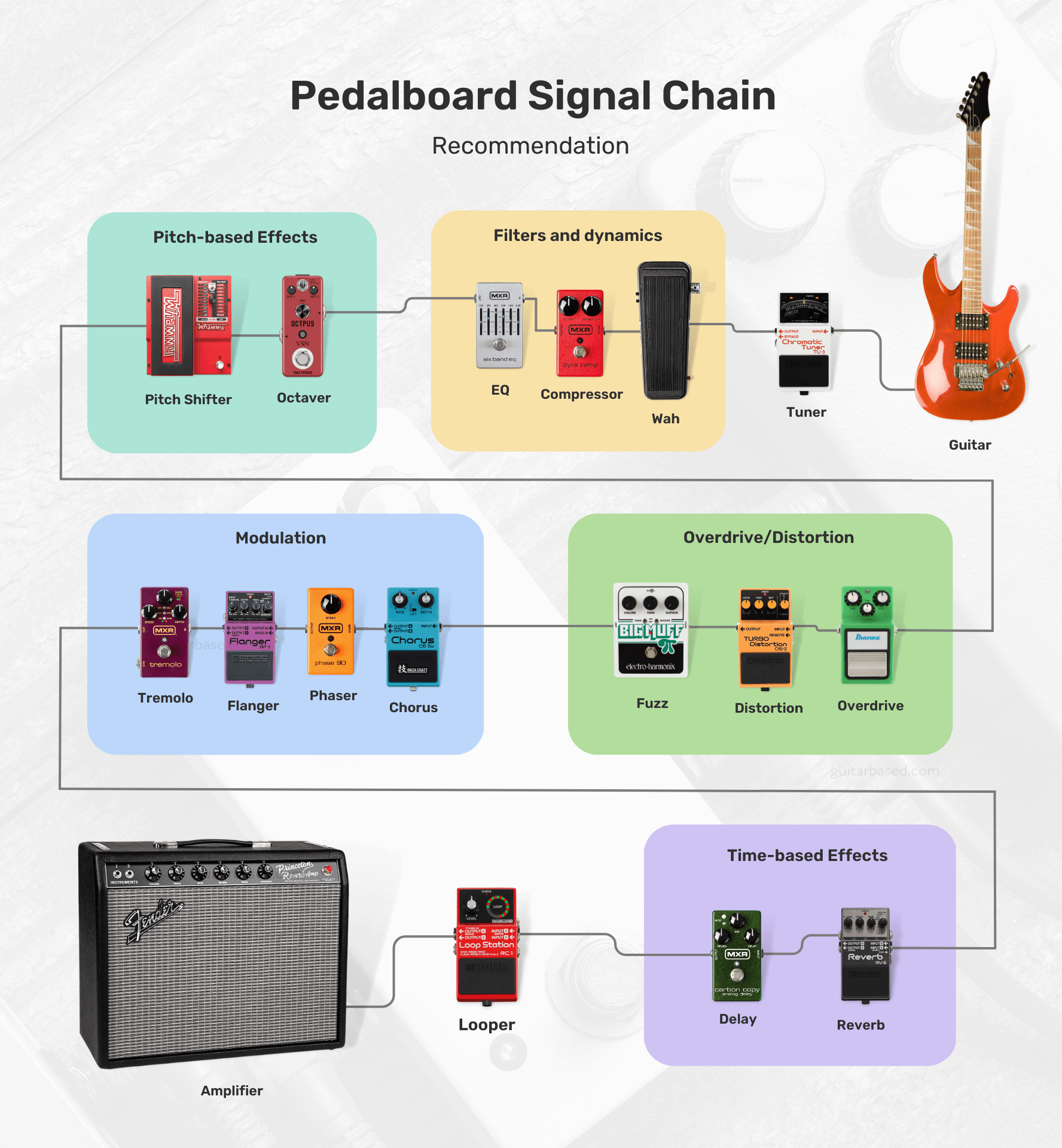
Feel free to swap the order of pedals, try different combinations, and test out unconventional setups until you find the one that works best for you.
For those interested, I’ll leave you with most of the possibilities that you’ll encounter and how to order them.
- Tuner
- Filters/Dynamics:
- Volume
- Wah
- Auto-Wah
- Compressor
- Noise Gate
- EQ (Equalizer)
- Pitch-based Effects:
- Octaver
- Harmonizer
- Pitch Shifter
- Overdrive/Distortion/Fuzz:
- Boost
- Overdrive
- Distortion
- Fuzz
- Modulation:
- Chorus
- Phaser
- Flanger
- Univibe
- Vibrato
- Tremolo
- Time-based Effects:
- Delay
- Echo
- Reverb
- Synth/Bitcrusher:
- Synth
- Bitcrusher
- Acoustic Simulator
- Multi-Effects
- Utility:
- Buffer
- A/B/Y Switcher
- MIDI Controllers
- Looper
Boutique vs. Mass-Produced pedals
Boutique pedals are generally built with higher-quality components and craftsmanship, resulting in better durability and longevity.
These pedals often feature unique and innovative designs, providing a wider range of tones and effects that may not be available in mass-produced options.
Here are a few examples of boutique pedals:

All the manufacturers also tend to have a more personal approach, with better customer service and the ability to customize pedals according to the user’s preferences.
However, boutique pedals are usually more expensive due to the smaller scale of production and the use of premium components.
Mass-produced pedals, on the other hand, are more affordable due to their larger scale of production and the use of cost-effective components.
These pedals are widely available and offer a range of popular effects, making them accessible to a larger audience.
Here are a few examples of mass-produced pedals:

The quality control for mass-produced pedals can vary depending on the brand and model, but many are reliable and offer good value for the money.
As for one of the downsides, you’ll find that mass-produced pedals may not have the same level of uniqueness or innovation as boutique options.
On the other hand, they may not provide the same level of customer service or customization options.
The choice between boutique and mass-produced pedals depends on your personal preferences, budget, and desired sound.
If you’re looking for unique tones, higher-quality components, and a more personal experience, boutique pedals may be the way to go.
But I would say, for those who are on a budget and need access to popular effects, mass-produced pedals might be a better fit.
It’s worth trying out both types to see which best suits your needs and playing style.
How much should you spend on a guitar pedal?
If I were in your position, I would first determine my budget and specific needs before deciding how much to spend on a guitar pedal.
For beginners, it might be more reasonable to start with affordable, mass-produced pedals to explore different effects without spending too much.
Guitar pedals can range in price from around $30 to over $400, depending on the brand, quality, and complexity of the effect.
As your skills and understanding of your preferred tone develop, you can gradually upgrade to higher-quality or boutique pedals.
One thing I would do is consider which effects are essential to your playing style and prioritize purchasing those first.
Allocating a larger portion of your budget to the most important pedals might be a wise choice, especially if you only need a few basic effects.
However, if you require a wide array of effects, you may want to consider more budget-friendly options or multi-effects units.
Keep in mind that higher-priced pedals often come with better build quality, unique features, and improved sound quality.
But I would also say that price is not always directly correlated with quality or suitability for your needs.
Sometimes, a more affordable pedal can deliver the exact sound you’re looking for, while a higher-priced option might not meet your expectations and are only expensive because of the brand reputation.
Can you use a guitar pedal with a bass guitar?
You can certainly use a guitar pedal with a bass guitar.
But it’s crucial to be aware that some guitar pedals may not be specifically designed to accommodate the frequency range of a bass guitar.
This could result in a less-than-ideal performance or an altered tone that might not be what you were expecting.
If you’re feeling adventurous and eager to experiment with your sound, don’t hesitate to connect your guitar pedals to your bass guitar.
This can be a fun way to explore different sonic possibilities, and you might even stumble upon some unique tones that complement your playing style perfectly.
Using a guitar pedal with a bass guitar may not always produce the desired results.
In some cases, the low-end frequencies might be lost, or the effect could sound too harsh or muddy.
To avoid these issues, you could consider looking into pedals that are specifically designed for bass guitars.
These pedals are engineered with the bass frequency range in mind, ensuring that your low-end remains intact and the effect sounds as intended.
In addition to bass-specific pedals, there are also multi-effects processors and pedals that cater to both guitar and bass players, offering a wide range of effects and tonal options.
These versatile units can be a great solution if you play both instruments and want a single device to cover your needs.
How to properly power your pedals?
When it comes to powering your pedals, you want to make sure you’re doing it right to avoid any noise issues or potential damage.
First, check each pedal’s power requirements, which you can usually find in the manual or on the pedal itself.
You’ll want to pay attention to the voltage (usually 9V, 12V, or 18V) and current (measured in milliamps or mA).
Now, you’ve got a few options for powering your pedals.
You can use individual power supplies or batteries for each pedal, but that can get messy and inconvenient.
I’d recommend going for a pedal power supply or an isolated power brick.

For example here are a few ones I recommend:
- Voodoo Lab Pedal Power 2 Plus Isolated Power Supply (My favorite)
- Rowin PW-1 Guitar Pedal Power Supply (Cheapest)
These babies can power multiple pedals at once, and the isolated outputs help prevent noise and ground loop issues.
Just make sure the power supply you choose can handle the voltage and current requirements of all your pedals.
When you’re connecting everything, use good quality power cables and keep them neat and tidy to avoid a tangled mess.
You might even want to use cable ties or cable organizers to keep everything in order.
In love with guitars, and gear; expert in all things music! Been writing about guitars for about 5 years and counting. Born in the ’90s. Alma Mater: University of Havana. Always curious, trying to understand the world. #TeamFender

